Access to Information and Privacy Statistical Report for the 2019 to 2020 Fiscal Year
Openness, transparency and accountability are guiding principles of the Government of Canada.
The Access to Information Act and the Privacy Act both came into effect on July 1, 1983.
Paragraph 70(1)(d) of the Access to Information Act assigns responsibility to the President of the Treasury Board, as the designated minister, to collect statistics on an annual basis. These statistics are used to assess the performance of the Government of Canada’s access to information and privacy programs.
This statistical report presents statistical information about the Government of Canada’s access to information and privacy programs globally across all federal institutions subject to the two Acts for the period of April 1, 2019, to March 31, 2020. It also presents cumulative data from July 1, 1983, to March 31, 2020.
In addition, each institution subject to the Access to Information Act and the Privacy Act tables an individual annual report in Parliament on the administration of each Act in their institution. These reports can be found on the institutions’ websites.
Eight institutions received the majority of access to information requests and personal information requests across the government. An annex providing detailed analysis of these institutions is included.
The complete statistical dataset for 2019‑2020 will be available in open format on the Government of Canada’s Open Data Portal.
On this page
- Access to Information Act statistics, for the 2019 to 2020 fiscal year
-
Privacy Act statistics, for the 2019 to 2020 fiscal year
In this section
- Requests under the Privacy Act
- Timeliness
- Disposition
- Complexity
- Consultations
- Extensions
- Exemptions
- Exclusions
- Costs
- Disclosures under subsection 8(2) of the Privacy Act
- Requests for correction of personal information and notations
- Privacy impact assessments
- Personal information banks
- Material Privacy Breaches
- Privacy Act requests since 1983
Access to Information Act statistics for the 2019 to 2020 fiscal year
Requests under the Access to Information Act
A total of 156,222 Access to Information (ATI) requests were received in the 2019 to 2020 fiscal year, an overall increase of 26.6 percent from the 2018 to 2019 fiscal year. There was also a total of 25,916 ATI requests that were outstanding from the 2018 to 2019 fiscal year, an overall decrease of 5.3 percent from the outstanding requests of the previous fiscal year.
Of the 182,138 ATI requests that were either received in the 2019 to 2020 fiscal year or outstanding from the previous fiscal year, 82 percent were closed. This is a slight decrease from the 2018 to 2019 fiscal year: of the 150,792 ATI requests received in the 2018 to 2019 fiscal year or outstanding from the previous fiscal year, 83 percent were closed.
Table 1 shows the number of ATI requests received, closed and carried over for the 2019 to 2020 fiscal year.
| ATI Requests | Number of requests |
|---|---|
| Outstanding from 2018 to 2019 reporting periodtable 1 note a | 25,916 |
| Received during 2019 to 2020 reporting period | 156,222 |
| Total | 182,138 |
| Closed during 2019 to 2020 reporting period | 149,570 |
| Carried over to 2020 to 2021 reporting period | 32,568 |
Table 1 Notes
|
|
Figure 1 shows the number of ATI requests received, closed and carried over from fiscal year 2018 to 2019 to fiscal year 2019 to 2020
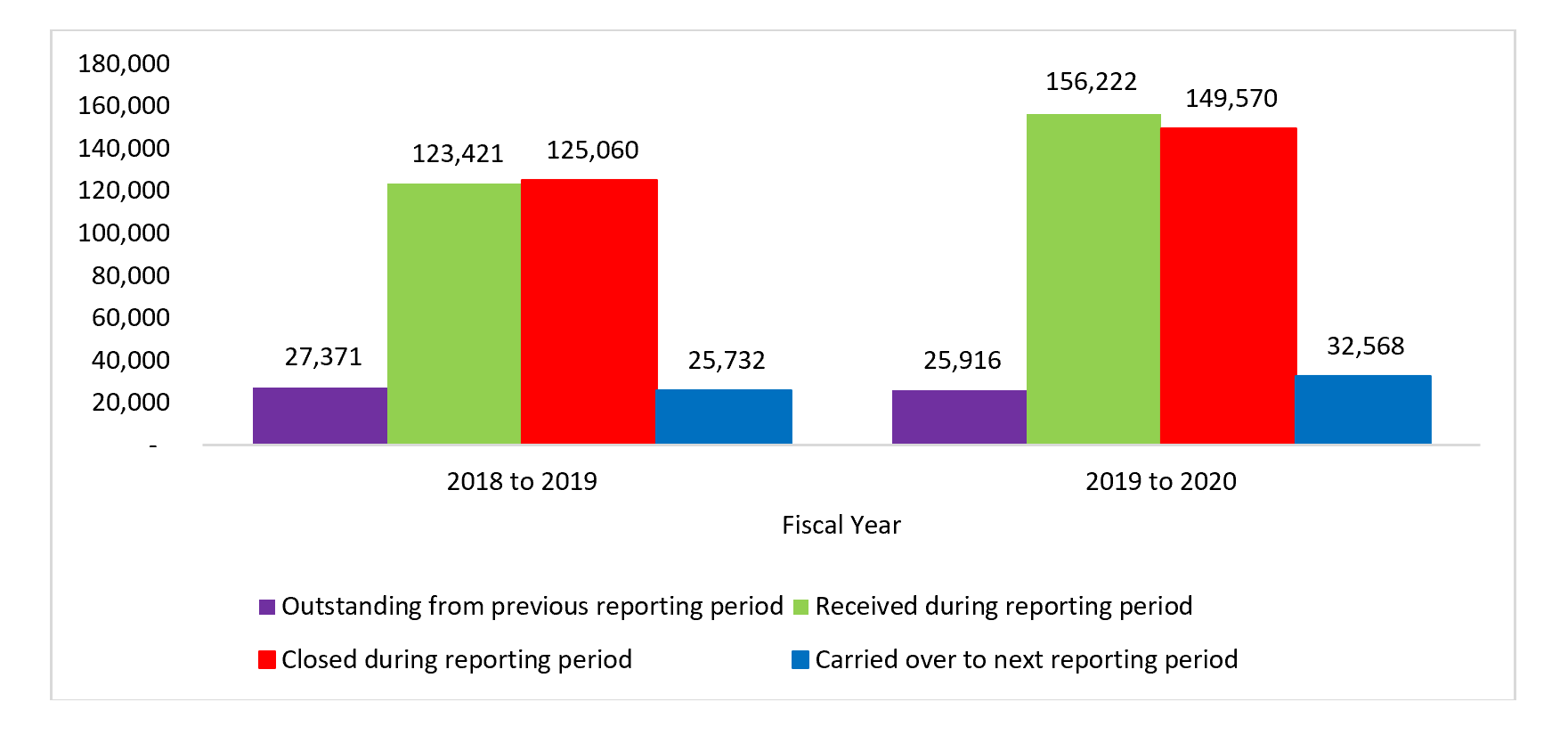
Figure 1 - Text version
| 2018 to 2019 | 2019 to 2020 | |
|---|---|---|
| Outstanding from previous reporting period | 27,371 | 25,916 |
| Received during reporting period | 123,421 | 156,222 |
| Closed during reporting period | 125,060 | 149,570 |
| Carried over to next reporting period | 25,732 | 32,568 |
Five government institutions received 86.2 percent of the 156,222 requests received in the 2019 to 2020 fiscal year.
Figure 2 shows the proportion of ATI requests received by the five institutions that received the highest volume of requests, and all other government institutions, for the 2019 to 2020 fiscal year.
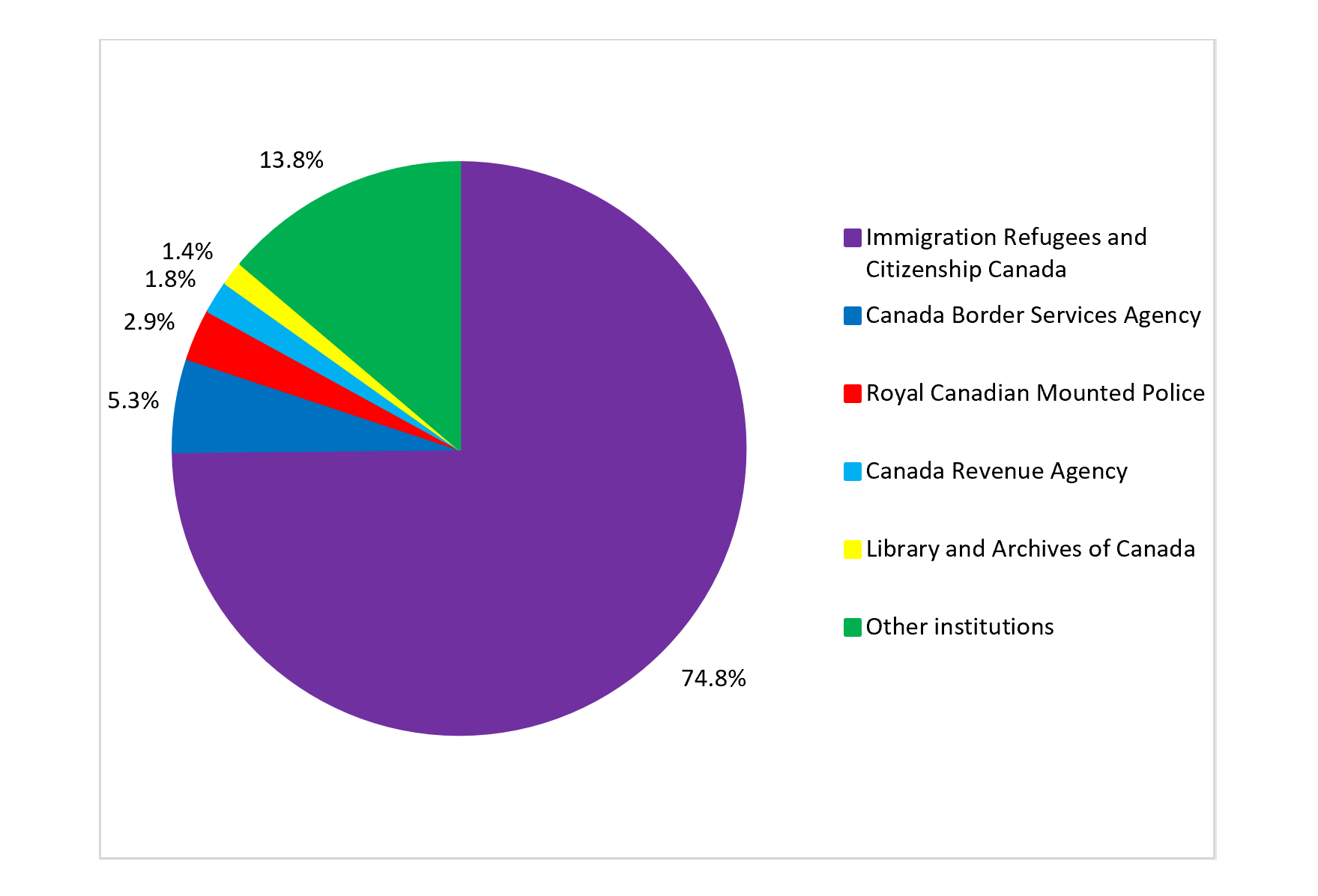
Figure 2 - Text version
| Immigration Refugees and Citizenship Canada | 74.8% |
|---|---|
| Canada Border Services Agency | 5.3% |
| Royal Canadian Mounted Police | 2.9% |
| Canada Revenue Agency | 1.8% |
| Library and Archives of Canada | 1.4% |
| Other institutions | 13.8% |
Table 2 shows the number of pages processed under the Access to Information Act by the five institutions that received the highest volume of requests, and all other government institutions, for the 2019 to 2020 fiscal year.
| Rank | Name of institution | Number of requests received | Requests received as percentage | Number of pages processedtable 2 note a |
|---|---|---|---|---|
| 1 | Immigration Refugees and Citizenship Canada | 116,928 | 74.8 | 7,787,738 |
| 2 | Canada Border Services Agency | 8,223 | 5.3 | 1,160,704 |
| 3 | Royal Canadian Mounted Police | 4,512 | 2.9 | 1,186,062 |
| 4 | Canada Revenue Agency | 2,864 | 1.8 | 1,953,575 |
| 5 | Library and Archives of Canada | 2,131 | 1.4 | 289,974 |
| Other institutions | 21,564 | 13.8 | 20,222,239 | |
| Total | 156,222 | 100 | 32,600,292 | |
Table 2 Notes
|
||||
Table 3 shows the sources of ATI requests made in the 2019 to 2020 fiscal year.
| Source | Number of requests | Percentage of requests |
|---|---|---|
| Business (private sector) | 81,182 | 52.0 |
| Public | 43,715 | 28.0 |
| Media | 6,886 | 4.4 |
| Organizationtable 3 note a | 7,669 | 4.9 |
| Academia | 5,674 | 3.6 |
| Decline to identifytable 3 note b | 11,096 | 7.1 |
| Total | 156,222 | 100 |
Table 3 Notes
|
||
Government-wide, business (private sector) accounted for 52.0 percent of ATI requests received, and the public accounted for 28.0 percent of ATI requests received.
Figure 3 shows the sources of ATI requests received, for the 2018 to 2019 fiscal year and the 2019 to 2020 fiscal year.
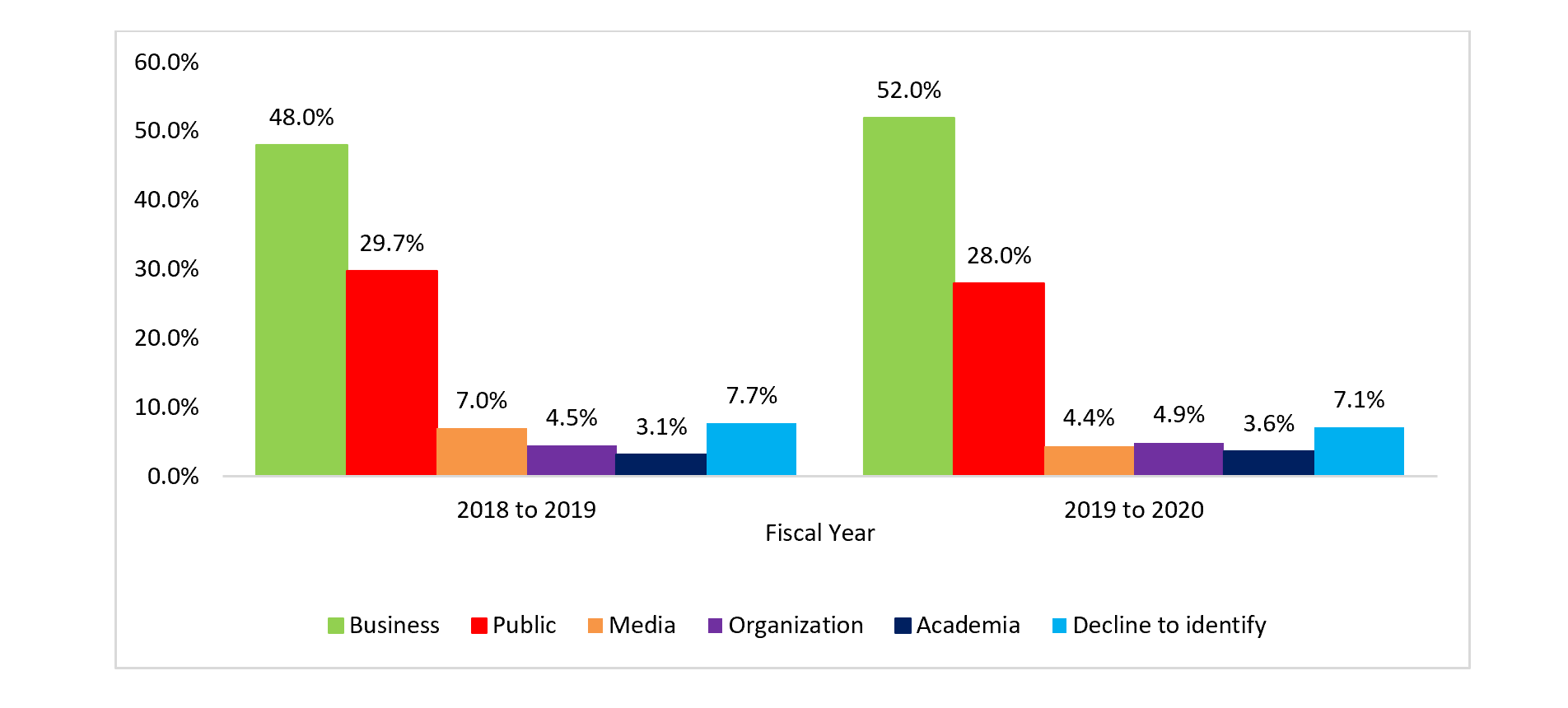
Figure 3 - Text version
| Source | 2018 to 2019 | 2019 to 2020 |
|---|---|---|
| Business | 48.0% | 52.0% |
| Public | 29.7% | 28.0% |
| Media | 7.0% | 4.4% |
| Organization | 4.5% | 4.9% |
| Academia | 3.1% | 3.6% |
| Decline to identify | 7.7% | 7.1% |
In June 2019, the Access to Information Act was amended to enable institutions to seek the Information Commissioner’s approval to decline to act on requests that are vexatious, made in bad faith, or an abuse of the right of access. In the 2019 to 2020 fiscal year, across the federal government, institutions sought the Information Commissioner’s approval to decline to act on six requests.
Table 4 shows the outcome of these proposals to the Information Commissioner to decline to act on an ATI request on the basis that the request is vexatious, made in bad faith, or an abuse of the right of access.
| Decline to act on vexatious, bad faith or abuse of right of access requests | Number of requests |
|---|---|
| Outstanding from 2018 to 2019 reporting period | 0 |
| Sent during 2019 to 2020 reporting period | 6 |
| Total | 6 |
| Approved by the Information Commissioner during 2019 to 2020 reporting period | 1 |
| Declined by the Information Commissioner during 2019 to 2020 reporting period | 4 |
| Carried over to the 2020 to 2021 reporting period | 1 |
Timeliness
Of the 149,570 ATI requests closed in the 2019 to 2020 fiscal year, 67.4 percent were closed within legislated timelines, including extensions. This is a decrease of 5.7 percent from the 2018 to 2019 fiscal year.
Table 5 shows ATI requests closed within the legislated timeline, including extensions, for the 2018 to 2019 fiscal year and the 2019 to 2020 fiscal year.
| Status of closed requests | Requests as percentage | Number of requests | ||
|---|---|---|---|---|
| 2018 to 2019 | 2019 to 2020 | 2018 to 2019 | 2019 to 2020 | |
| Closed within legislated timeline, including extensions | 73.1 | 67.4 | 91,402 | 100,827 |
| Closed beyond legislated timeline, including extensions | 26.9 | 32.6 | 33,658 | 48,743 |
| Total | 100 | 100 | 125,060 | 149,570 |
The percentage of ATI requests closed within legislated timelines has decreased by 18.5 percent over the last five fiscal years, from 85.9 percent in the 2015 to 2016 fiscal year to 67.4 percent in the 2019 to 2020 fiscal year.
Figure 4 shows ATI requests closed within legislated timelines, from the 2015 to 2016 fiscal year to the 2019 to 2020 fiscal year.
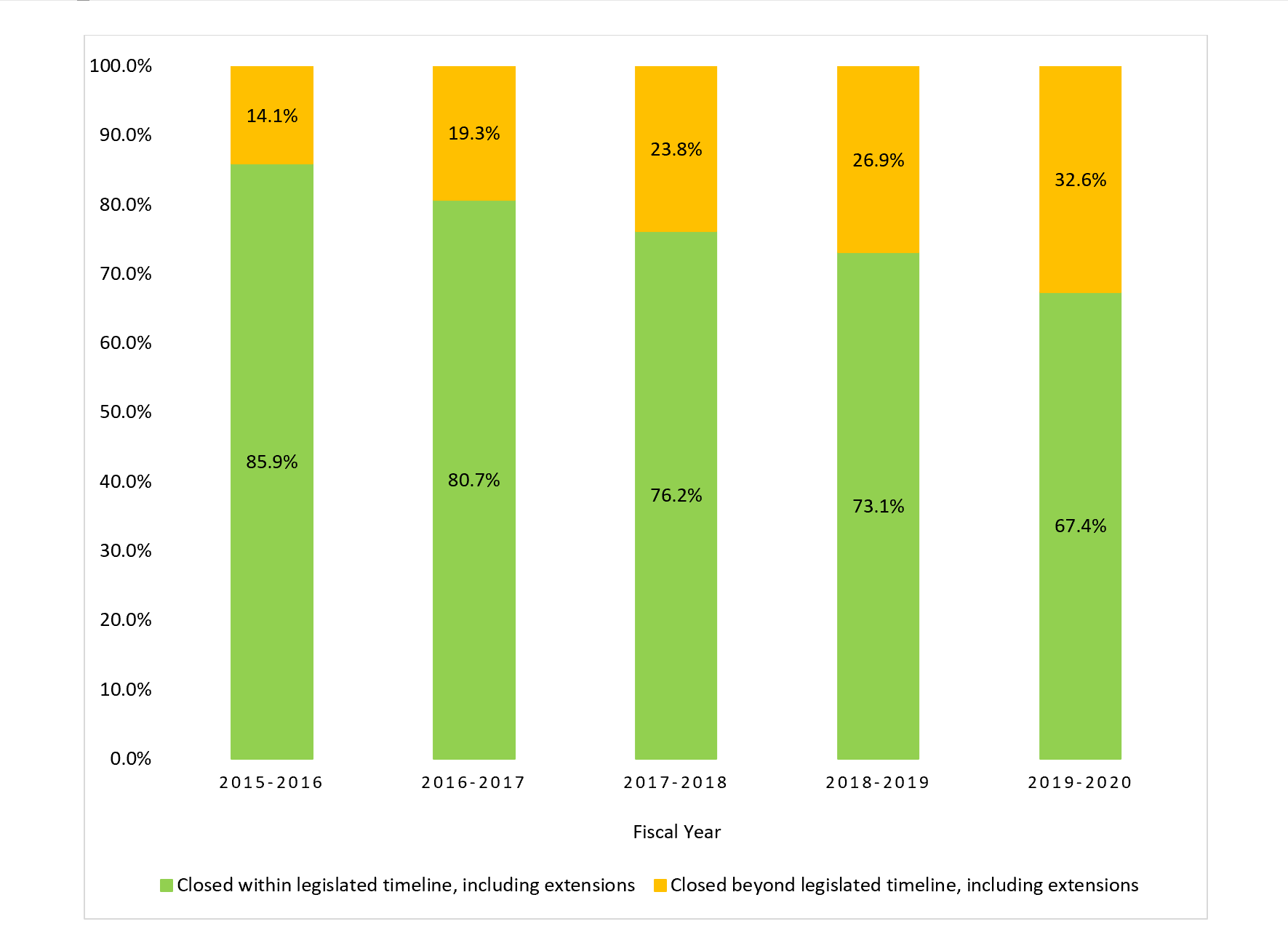
Figure 4 - Text version
| 2015-2016 | 2016-2017 | 2017-2018 | 2018‑2019 | 2019‑2020 | |
|---|---|---|---|---|---|
| Closed within legislated timeline, including extensions | 85.9% | 80.7% | 76.2% | 73.1% | 67.4% |
| Closed beyond legislated timeline, including extensions | 14.1% | 19.3% | 23.8% | 26.9% | 32.6% |
Another way to examine performance is to consider the number of institutions that meet the performance standard for ATI requests, which is to respond to 90 percent of requests within legislated timelines, including extensions. Of the 138 institutions that closed ATI requests in the 2019 to 2020 fiscal year, 84 institutions met this standard, closing at least 90 percent of requests within legislated timelines. 54 institutions did not meet this standard, principally due to workload pressures within the organization. Of the 45 institutions that did not close any requests in the 2019 to 2020 fiscal year, 42 institutions did not receive any requests and 3 institutions received requests.
Table 6 shows the number of institutions that closed at least 90 percent of ATI requests within legislated timelines, from the 2015 to 2016 fiscal year to the 2019 to 2020 fiscal year.
| Number of institutions | 2015 to 2016 | 2016 to 2017 | 2017 to 2018 | 2018 to 2019 | 2019 to 2020 |
|---|---|---|---|---|---|
| Number of institutions that closed at least 90 percent of requests within legislated timelines | 85 | 90 | 85 | 74 | 84 |
| Number of institutions that closed fewer than 90 percent of requests within legislated timelines | 68 | 64 | 55 | 59 | 54 |
| Number of institutions that did not close any requests | 22 | 22 | 41 | 48 | 45 |
| Total | 175 | 176 | 181 | 181 | 183 |
Figure 5 shows the percentage of reporting institutions that closed at least 90 percent of ATI requests within legislated timelines, from the 2015 to 2016 fiscal year to the 2019 to 2020 fiscal year.
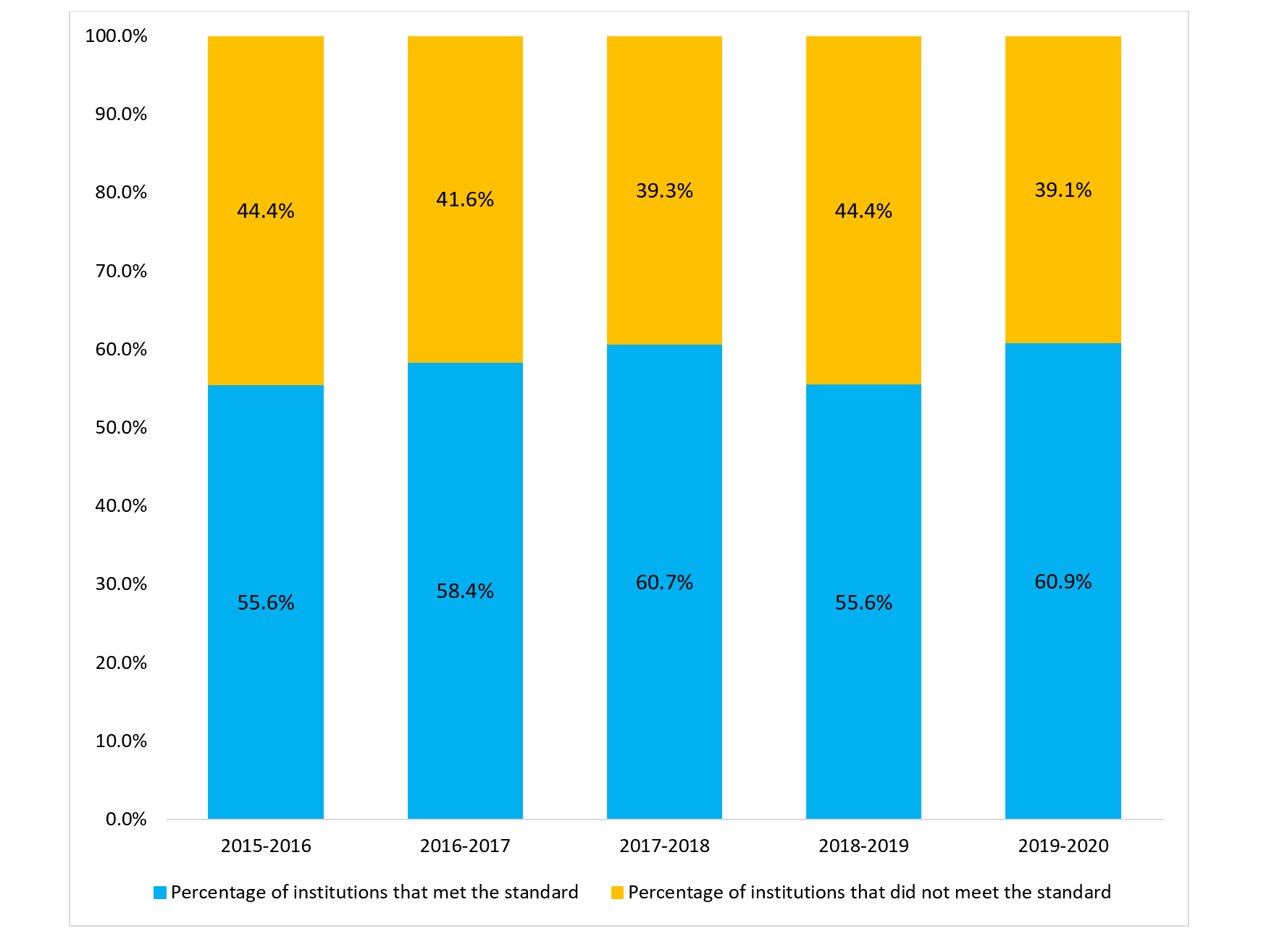
Figure 5 - Text version
| 2015-2016 | 2016-2017 | 2017-2018 | 2018‑2019 | 2019‑2020 | |
|---|---|---|---|---|---|
| Percentage of institutions that met the standard | 55.6% | 58.4% | 60.7% | 55.6% | 60.9% |
| Percentage of institutions that did not meet the standard | 44.4% | 41.6% | 39.3% | 44.4% | 39.1% |
Table 7 shows the disposition of ATI requests, and the time required to close these requests, for the 2019 to 2020 fiscal year.
| Disposition of requests (including requests for which extensions were required) | Closure timeTable 7 note a | |||||||
|---|---|---|---|---|---|---|---|---|
| 1 to 15 days | 16 to 30 days | 31 to 60 days | 61 to 120 days | 121 to 180 days | 181 to 365 days | More than 365 days | Total | |
| All disclosed | 1,495 | 19,520 | 10,106 | 4,343 | 766 | 579 | 251 | 37,060 |
| Disclosed in part | 1,395 | 41,400 | 28,400 | 12,705 | 3,882 | 3,926 | 2,880 | 94,588 |
| All exempted | 159 | 267 | 116 | 127 | 44 | 59 | 69 | 841 |
| All excluded | 115 | 87 | 43 | 57 | 23 | 10 | 8 | 343 |
| No records exist | 1,541 | 3,121 | 1,072 | 460 | 113 | 80 | 96 | 6,483 |
| Request transferred | 367 | 34 | 1 | 3 | 3 | 0 | 0 | 408 |
| Request abandonedTable 7 note b | 5,461 | 1,296 | 1,044 | 330 | 153 | 182 | 1,116 | 9,582 |
| Neither confirmed nor deniedTable 7 note c | 97 | 100 | 20 | 20 | 4 | 6 | 17 | 264 |
| Decline to act with the approval of the Information Commissioner | 0 | 0 | 0 | 1 | 0 | 0 | 0 | 1 |
| Total number of requests | 10,630 | 65,825 | 40,802 | 18,046 | 4,988 | 4,842 | 4,437 | 149,570 |
| Total as percentage | 7.1 | 44.0 | 27.3 | 12.1 | 3.3 | 3.2 | 3.0 | 100 |
Table 7 Notes
|
||||||||
Figure 6 shows the time required to close ATI requests from fiscal year 2015 to 2016 to fiscal year 2019 to 2020.
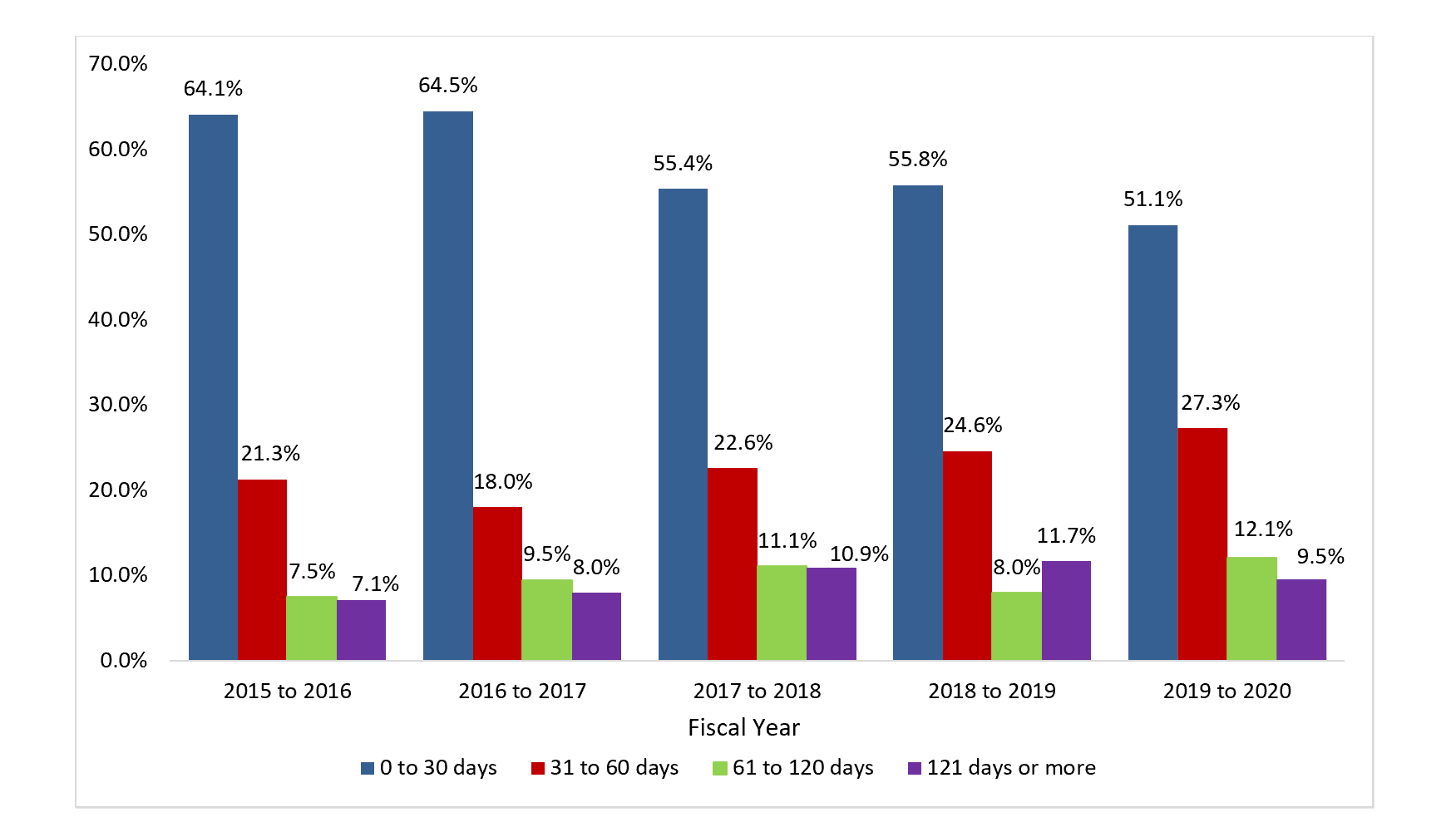
Figure 6 - Text version
| 2015 to 2016 | 2016 to 2017 | 2017 to 2018 | 2018 to 2019 | 2019 to 2020 | |
|---|---|---|---|---|---|
| 0 to 30 days | 64.1% | 64.5% | 55.4% | 55.8% | 51.1% |
| 31 to 60 days | 21.3% | 18.0% | 22.6% | 24.6% | 27.3% |
| 61 to 120 days | 7.5% | 9.5% | 11.1% | 8.0% | 12.1% |
| 121 days or more | 7.1% | 8.0% | 10.9% | 11.7% | 9.5% |
Table 8 shows the principal reason that ATI requests were closed beyond the legislated timeline for fiscal year 2019 to 2020.
| Principal reason | Total number of requests closed beyond the legislated timeline including extensions |
|---|---|
| Workload | 46,283 |
| External consultation | 736 |
| Internal consultation | 461 |
| OtherTable 8 note a | 1,263 |
| Total | 48,743 |
Table 8 Notes
Note: Requests that were neither closed in the initial 30-day legislated timeline nor within the timeframe covered by an extension. |
|
Of the 48,743 ATI requests closed beyond the legislated timeline, 89.9 percent were past the timeline with no extension taken. This is an increase of 4.5 percent from the 2018 to 2019 fiscal year.
Table 9 shows the number of ATI requests that were closed beyond the legislated timeline in fiscal year 2019 to 2020, by number of days past the timeline.
| Number of days past legislated timeline | Number of requests past legislated timeline where no extension was taken | Number of requests past legislated timeline where an extension was taken | Total requests closed beyond the legislated timeline including extensions | Total as percentage |
|---|---|---|---|---|
| 1 to 15 days | 24,150 | 1,417 | 25,567 | 52.5 |
| 16 to 30 days | 3,206 | 401 | 3,607 | 7.4 |
| 31 to 60 days | 4,484 | 461 | 4,945 | 10.1 |
| 61 to 120 days | 4,375 | 551 | 4,926 | 10.1 |
| 121 to 180 days | 2,154 | 362 | 2,516 | 5.2 |
| 181 to 365 days | 2,839 | 606 | 3,445 | 7.1 |
| More than 365 days | 2,591 | 1,146 | 3,737 | 7.7 |
| Total | 43,799 | 4,944 | 48,743 | 100 |
Disposition
Records were disclosed either in full or in part for 88 percent of closed ATI requests. This is an increase of 4 percent from the 2018 to 2019 fiscal year.
Table 10 shows the disposition of closed ATI requests for fiscal year 2018 to 2019 and fiscal year 2019 to 2020.
| Disposition of closed requests | Requests as percentage | Number of requests | ||
|---|---|---|---|---|
| 2018 to 2019 | 2019 to 2020 | 2018 to 2019 | 2019 to 2020 | |
| All disclosed | 27.0 | 24.8 | 33,709 | 37,060 |
| Disclosed in part | 57.1 | 63.2 | 71,353 | 94,588 |
| All exempted | 0.7 | 0.6 | 925 | 841 |
| All excluded | 0.4 | 0.2 | 483 | 343 |
| No records exist | 5.3 | 4.3 | 6,590 | 6,483 |
| Request transferred | 0.4 | 0.3 | 486 | 408 |
| Request abandoned | 9.0 | 6.4 | 11,243 | 9,582 |
| Neither confirmed nor denied | 0.2 | 0.2 | 271 | 264 |
| Decline to act with the approval of the Information Commissioner | N/A | 0.0 | N/A | 1 |
| Total | 100 | 100 | 125,060 | 149,570 |
Figure 7 shows the disposition of closed ATI requests in fiscal year 2018 to 2019 and fiscal year 2019 to 2020.
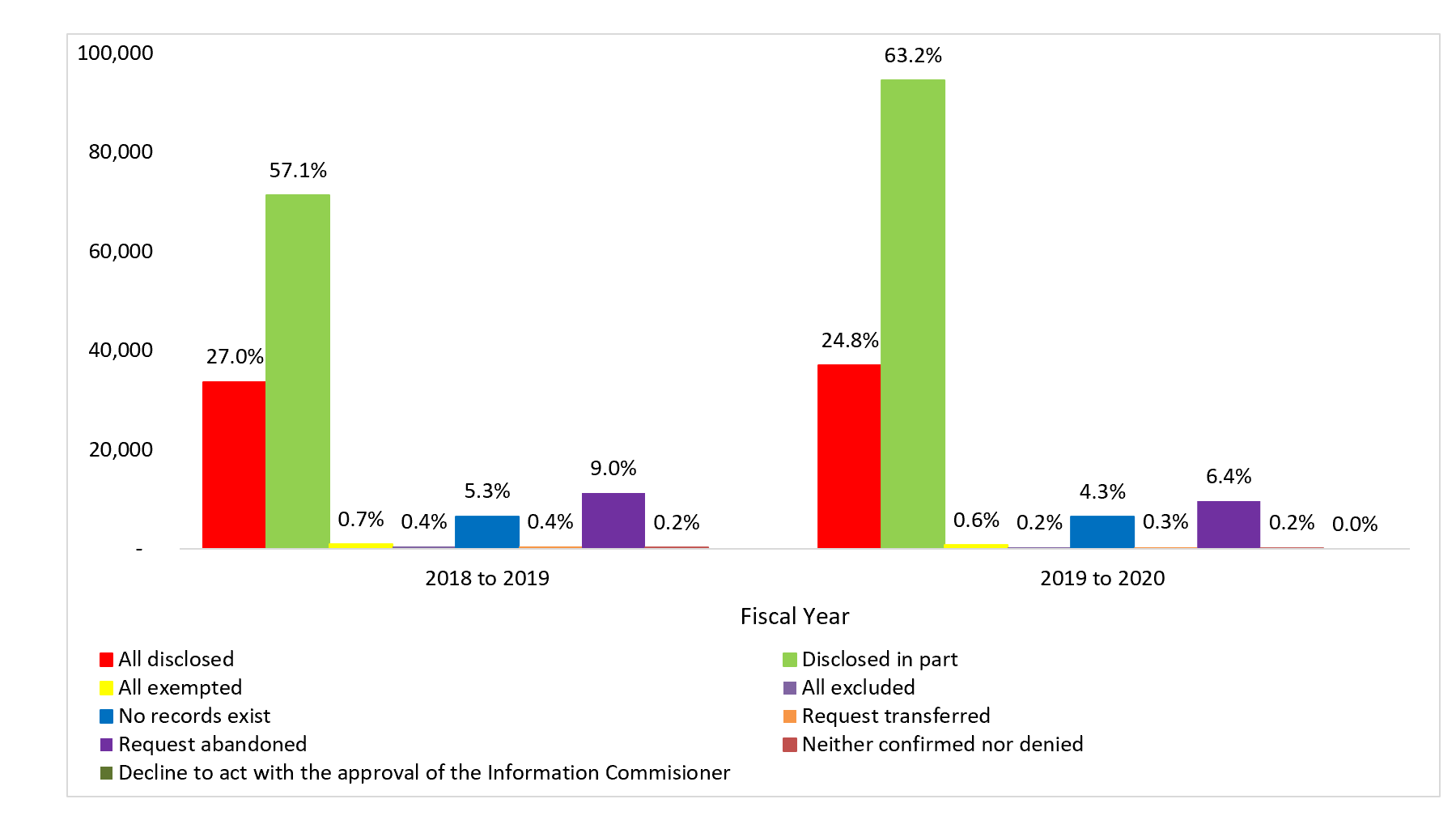
Figure 7 - Text version
| 2018‑19 | 2019‑20 | |
|---|---|---|
| All disclosed | 27.0% | 24.8% |
| Disclosed in part | 57.1% | 63.2% |
| All exempted | 0.7% | 0.6% |
| All excluded | 0.4% | 0.2% |
| No records exist | 5.3% | 4.3% |
| Request transferred | 0.4% | 0.3% |
| Request abandoned | 9.0% | 6.4% |
| Neither confirmed nor denied | 0.2% | 0.2% |
| Decline to act with the approval of the Information Commisioner | 0.0% | 0.0% |
Complexity
In the 2019 to 2020 fiscal year, government institutions processed about 32.6 million pages for closed ATI requests, an increase of about 17 million pages over the 2018 to 2019 fiscal year. The increase is largely attributable to one institution closing three ATI requests on the same subject involving nearly 15 million pages in total.
Government institutions undertook consultations with parties outside the federal government in 6.4 percent of all closed ATI requests. This is a decrease of 2 percent from the 2018 to 2019 fiscal year.
Table 11 shows the number of relevant pages processed and disclosed in response to ATI requests closed in fiscal year 2018 to 2019 and fiscal year 2019 to 2020.
| Number of pages processed | Number of pages disclosed | Number of requestsTable 11 note a | ||||
|---|---|---|---|---|---|---|
| 2018 to 2019 | 2019 to 2020 | 2018 to 2019 | 2019 to 2020 | 2018 to 2019 | 2019 to 2020 | |
| Total | 15,553,195 | 32,600,292Table 11 note b | 10,791,635 | 13,271,901 | 117,713 | 142,678 |
Table 11 Notes
|
||||||
Figure 8 shows the number of pages processed in response to closed ATI requests from fiscal year 2015 to 2016 to fiscal year 2019 to 2020.
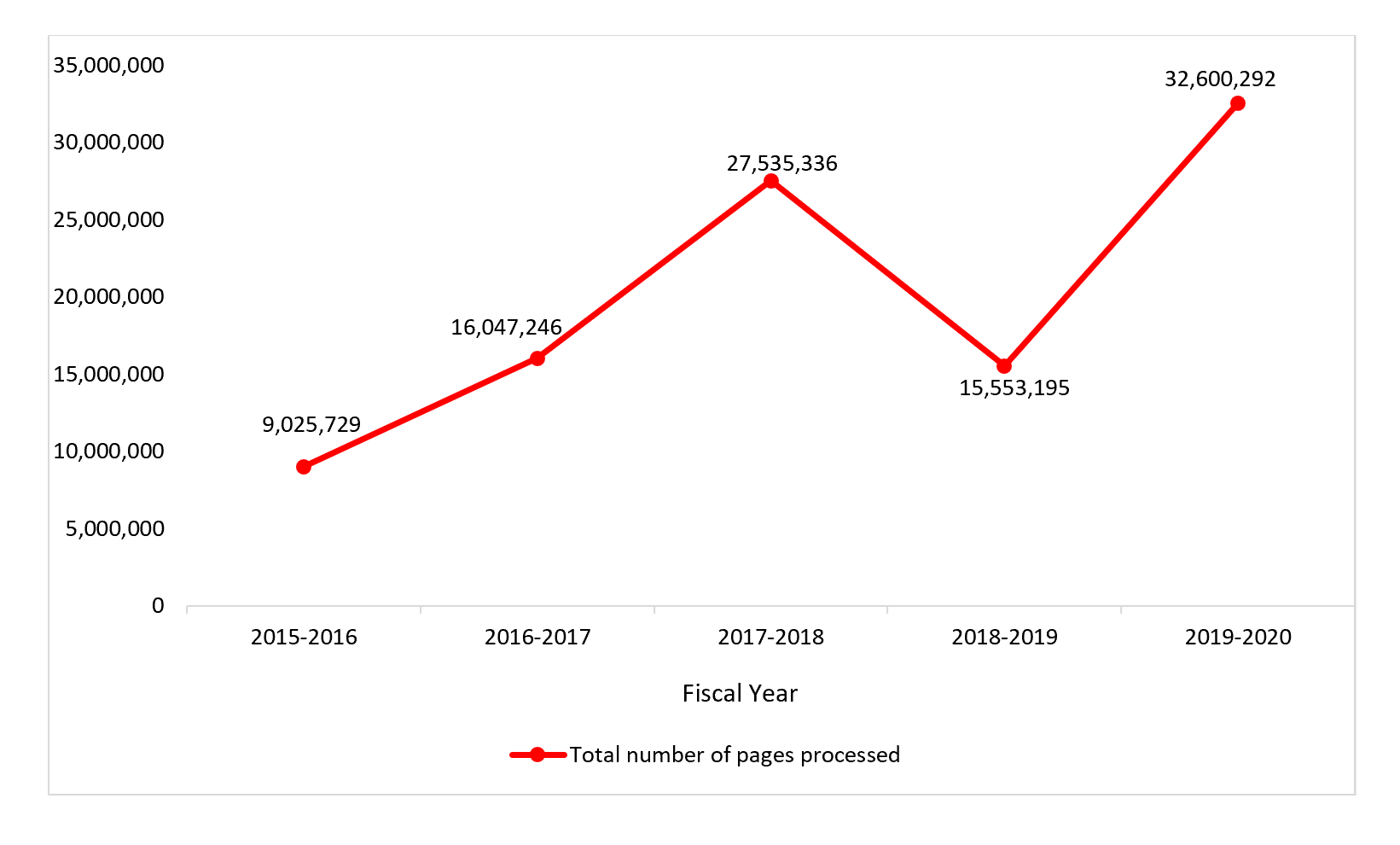
Figure 8 - Text version
| 2015-2016 | 2016-2017 | 2017-2018 | 2018‑2019 | 2019‑2020 | |
|---|---|---|---|---|---|
| Total number of pages processed | 9,025,729 | 16,047,246 | 27,535,336 | 15,553,195 | 32,600,292 |
Note: The number of pages processed rose significantly in the 2017 to 2018 fiscal year due to 1 request of approximately 14.8 million pages. The number of pages once again rose significantly in the 2019 to 2020 fiscal year due to one institution closing three requests on the same subject involving nearly 15 million pages in total.
Table 12 shows the number of complex ATI requests closed in fiscal year 2019 to 2020, by disposition.
| Disposition | Consultation required | Assessment of fees | Legal advice sought | Othertable 12 note 1 | Total |
|---|---|---|---|---|---|
| All disclosed | 1,410 | 3 | 36 | 326 | 1,775 |
| Disclosed in part | 7,577 | 6 | 378 | 1,042 | 9,003 |
| All exempted | 100 | 1 | 22 | 27 | 150 |
| All excluded | 146 | 0 | 14 | 9 | 169 |
| Request abandoned | 279 | 7 | 17 | 101 | 404 |
| Neither confirmed nor denied | 6 | 0 | 3 | 6 | 15 |
| Total | 9,518 | 17 | 470 | 1,511 | 11,516 |
Table 12 Notes
|
|||||
Extensions
49.3 percent of all extensions taken for closed requests cited paragraph 9(1)(a) of the Access to Information Act as a reason for the extension, relating to interference with government operations. 19.1 percent of all extensions taken for closed requests were for 30 days or less; 93.3 percent were for 120 days or less.
Table 13 shows the number of ATI requests that were closed in fiscal year 2019 to 2020 where extensions were invoked, by length of the extension.
| Length of extensionsTable 13 note a | 9(1)(a) - Interference with operations | 9(1)(b) - Consultation | 9(1)(c) - Third-party notice | Total | |
|---|---|---|---|---|---|
| Section 69Table 13 note b | OtherTable 13 note c | ||||
| 30 days or less | 2,879 | 59 | 1,023 | 113 | 4,074 |
| 31 to 60 days | 3,243 | 174 | 4,271 | 1,824 | 9,512 |
| 61 to 120 days | 3,795 | 534 | 1,676 | 290 | 6,295 |
| 121 to 180 days | 274 | 120 | 379 | 56 | 829 |
| 181 to 365 days | 241 | 36 | 141 | 32 | 450 |
| 365 days or more | 74 | 10 | 55 | 13 | 152 |
| Total | 10,506 | 933 | 7,545 | 2,328 | 21,312 |
Table 13 Notes
|
|||||
Consultations
The number of ATI requests for consultation between federal government institutions in the 2019 to 2020 fiscal year increased by 5.1 percent from the 2018 to 2019 fiscal year. The number of pages to review decreased by 16.2 percent.
Table 14 shows the number of ATI requests for consultation in fiscal year 2018 to 2019 and fiscal year 2019 to 2020 between government institutions and the number of pages reviewed in connection with those requests.
| Consultations | Number of requests for consultations | Number of pages to review | ||
|---|---|---|---|---|
| 2018 to 2019 | 2019 to 2020 | 2018 to 2019 | 2019 to 2020 | |
| Received during reporting period | 9,692 | 10,187 | 480,689 | 402,943 |
| Outstanding from the previous reporting period | 1,434 | 1,759 | 271,251 | 227,884 |
| Total | 11,126 | 11,946 | 751,940 | 630,827 |
| Closed during the reporting period | 9,356 | 9,980 | 490,453 | 435,841 |
| Pending at the end of the reporting period | 1,766 | 1,966 | 261,416 | 195,021 |
Table 15 shows, by recommendation, the number of ATI requests for consultation that were closed within particular timeframes in fiscal year 2019 to 2020.
| Recommendation | Number of days required to close consultation requests | |||||||
|---|---|---|---|---|---|---|---|---|
| 1 to 15 days | 16 to 30 days | 31 to 60 days | 61 to 120 days | 121 to 180 days | 181 to 365 days | More than 365 days | Total | |
| Disclose entirely | 2,494 | 1,689 | 981 | 410 | 90 | 49 | 10 | 5,723 |
| Disclose in part | 602 | 833 | 840 | 520 | 154 | 152 | 110 | 3,211 |
| Exempt entirely | 58 | 37 | 31 | 18 | 5 | 1 | 2 | 152 |
| Exclude entirely | 16 | 9 | 2 | 5 | 1 | 0 | 1 | 34 |
| Consult other institutionTable 15 note a | 61 | 47 | 45 | 25 | 3 | 3 | 5 | 189 |
| Other | 297 | 78 | 73 | 109 | 34 | 62 | 18 | 671 |
| Total | 3,528 | 2,693 | 1,972 | 1,087 | 287 | 267 | 146 | 9,980 |
Table 15 Notes
|
||||||||
ExemptionsFootnote 1
The tables that follow show the number of ATI requests closed in fiscal year 2019 to 2020 in which specific exemptions under the Access to Information Act were invoked.
| Provision | Number of requests |
|---|---|
| 13(1)(a) | 7,845 |
| 13(1)(b) | 246 |
| 13(1)(c) | 660 |
| 13(1)(d) | 248 |
| 13(1)(e) | 33 |
| Provision | Number of requests |
|---|---|
| 14 | 546 |
| 14(a) | 356 |
| 14(b) | 151 |
| Provision | Number of requests |
|---|---|
| 15(1) | 12,550 |
| 15(1) International Affairs | 1,160 |
| 15(1) Defence | 418 |
| 15(1) Subversive activities | 2,055 |
| Provision | Number of requests |
|---|---|
| 16(1)(a)(i) | 1,025 |
| 16(1)(a)(ii) | 413 |
| 16(1)(a)(iii) | 454 |
| 16(1)(b) | 845 |
| 16(1)(c) | 26,229 |
| 16(1)(d) | 62 |
| 16(2) | 1,463 |
| 16(2)(a) | 21 |
| 16(2)(b) | 12 |
| 16(2)(c) | 2,723 |
| 16(3) | 2 |
| 16.1(1)(a) | 9 |
| 16.1(1)(b) | 15 |
| 16.1(1)(c) | 24 |
| 16.1(1)(d) | 22 |
| 16.2(1) | 10 |
| 16.3 | 8 |
| 16.31 | 0 |
| 16.4(1)(a) | 1 |
| 16.4(1)(b) | 0 |
| 16.5 | 16 |
| 16.6 | 8 |
| Provision | Number of requests |
|---|---|
| 17 | 33,990 |
| Provision | Number of requests |
|---|---|
| 18(a) | 145 |
| 18(b) | 454 |
| 18(c) | 11 |
| 18(d) | 229 |
| 18.1(1)(a) | 34 |
| 18.1(1)(b) | 35 |
| 18.1(1)(c) | 9 |
| 18.1(1)(d) | 8 |
| Provision | Number of requests |
|---|---|
| 19(1) | 62,033 |
| Provision | Number of requests |
|---|---|
| 20(1)(a) | 114 |
| 20(1)(b) | 2,384 |
| 20(1)(b.1) | 73 |
| 20(1)(c) | 2,077 |
| 20(1)(d) | 523 |
| 20.1 | 6 |
| 20.2 | 0 |
| 20.4 | 0 |
| Provision | Number of requests |
|---|---|
| 21(1)(a) | 3,516 |
| 21(1)(b) | 3,988 |
| 21(1)(c) | 855 |
| 21(1)(d) | 390 |
| Provision | Number of requests |
|---|---|
| 22 | 221 |
| 22.1(1) | 41 |
| Provision | Number of requests |
|---|---|
| 23 | 2,040 |
| Provision | Number of requests |
|---|---|
| 23.1 | 18 |
| Provision | Number of requests |
|---|---|
| 24(1) | 2,205 |
| Provision | Number of requests |
|---|---|
| 26 | 112 |
ExclusionsFootnote 2
The tables that follow show the number of ATI requests closed in fiscal year 2019 to 2020 in which specific exclusions under the Access to Information Act were invoked.
| Provision | Number of requests |
|---|---|
| 68(a) | 453 |
| 68(b) | 19 |
| 68(c) | 14 |
| 68.1 | 64 |
| 68.2(a) | 1 |
| 68.2(b) | 0 |
| Provision | Number of requests |
|---|---|
| 69(1) | 78 |
| 69(1)(a) | 201 |
| 69(1)(b) | 12 |
| 69(1)(c) | 67 |
| 69(1)(d) | 140 |
| 69(1)(e) | 312 |
| 69(1)(f) | 45 |
| 69(1)(g) re (a) | 1,017 |
| 69(1)(g) re (b) | 27 |
| 69(1)(g) re (c) | 636 |
| 69(1)(g) re (d) | 304 |
| 69(1)(g) re (e) | 528 |
| 69(1)(g) re (f) | 291 |
| Provision | Number of requests |
|---|---|
| 69.1(1) | 3 |
Fees and costs
The annual cost to administer the Government of Canada’s access to information program increased by 5.4 percent to about $78.5 million in the 2019 to 2020 fiscal year, with the average cost per closed request declining by 11.9 percent to about $525 per request.
Table 18 shows the fees and costs associated with administering the Access to Information Act for the 2018 to 2019 fiscal year and the 2019 to 2020 fiscal year.
| Description | Amount | |
|---|---|---|
| 2018 to 2019 | 2019 to 2020 | |
| Cost of institutions’ operationsTable 18 note a | $73,373,705 | $77,469,191 |
| Cost of ATIP Online Request ServiceTable 18 noteb | $1,079,623 | $987,919 |
| Total | $74,453,328 | $78,457,110 |
| Requests closed | 125,060 | 149,570 |
| Average cost per closed requestTable 18 note c | $595.34 | $524.55 |
| Pages processed | 15,553,195 | 32,600,292 |
| Average cost per processed page | $4.79 | $2.41 |
| Number of requests in which fees were collected | 116,443 | 148,791 |
| Fees collected | $582,473 | $743,955 |
| Average fees collected per request | $5.00 | $5.00 |
| Number of requests in which fees were waived or refunded | 7,093 | 5,584 |
| Fees waived or refunded | $40,968 | $35,319 |
| Average fees waived or refunded per request | $5.78 | $6.33 |
Table 18 Notes
|
||
Informal requests for government information
An informal request is a request for information made to a government institution subject to the Access to Information Act that is either not made or not processed under the Act.
Informal requests include:
- formal requests that are discontinued in favour of providing information informally, in consultation with the requester
- requests where the information sought is already publicly available online
- requests where the response involves re-releasing information that was made available in response to previously closed formal requests, summaries of which are found online.
Informal requests do not include:
- responses to parliamentary questions or media enquiries
- requests made internally within a government institution to share information between sectors
Unlike in the case of formal requests:
- fees cannot be charged for informal requests
- there are no deadlines for responding to informal requests
- requesters have no statutory right of complaint to the Information Commissioner
In the 2019 to 2020 fiscal year, 58.4 percent of informal requests were closed within 30 days. This is a decrease of 1.2 percent from the 2018 to 2019 fiscal year.
Table 19 shows the time required to close informal requests in the 2019 to 2020 fiscal year.
| Closure time | ||||||||
|---|---|---|---|---|---|---|---|---|
| 1 to 15 days | 16 to 30 days | 31 to 60 days | 61 to 120 days | 121 to 180 days | 181 to 365 days | More than 365 days | Total | |
| Number of requests | 7,541 | 3,135 | 2,245 | 1,641 | 547 | 1,255 | 1,930 | 18,294 |
Access to Information Act requests since 1983
The statistics that follow reflect the best available data since 1983. The categories have been adjusted in some cases in order to compare data across the years.
Table 20 shows the number of ATI requests received and closed since 1983.
| ATI Requests | Number of requests |
|---|---|
| Requests received | 1,259,174 |
| Requests closed | 1,221,486 |
Figure 9 shows the disposition of ATI requests closed since 1983.
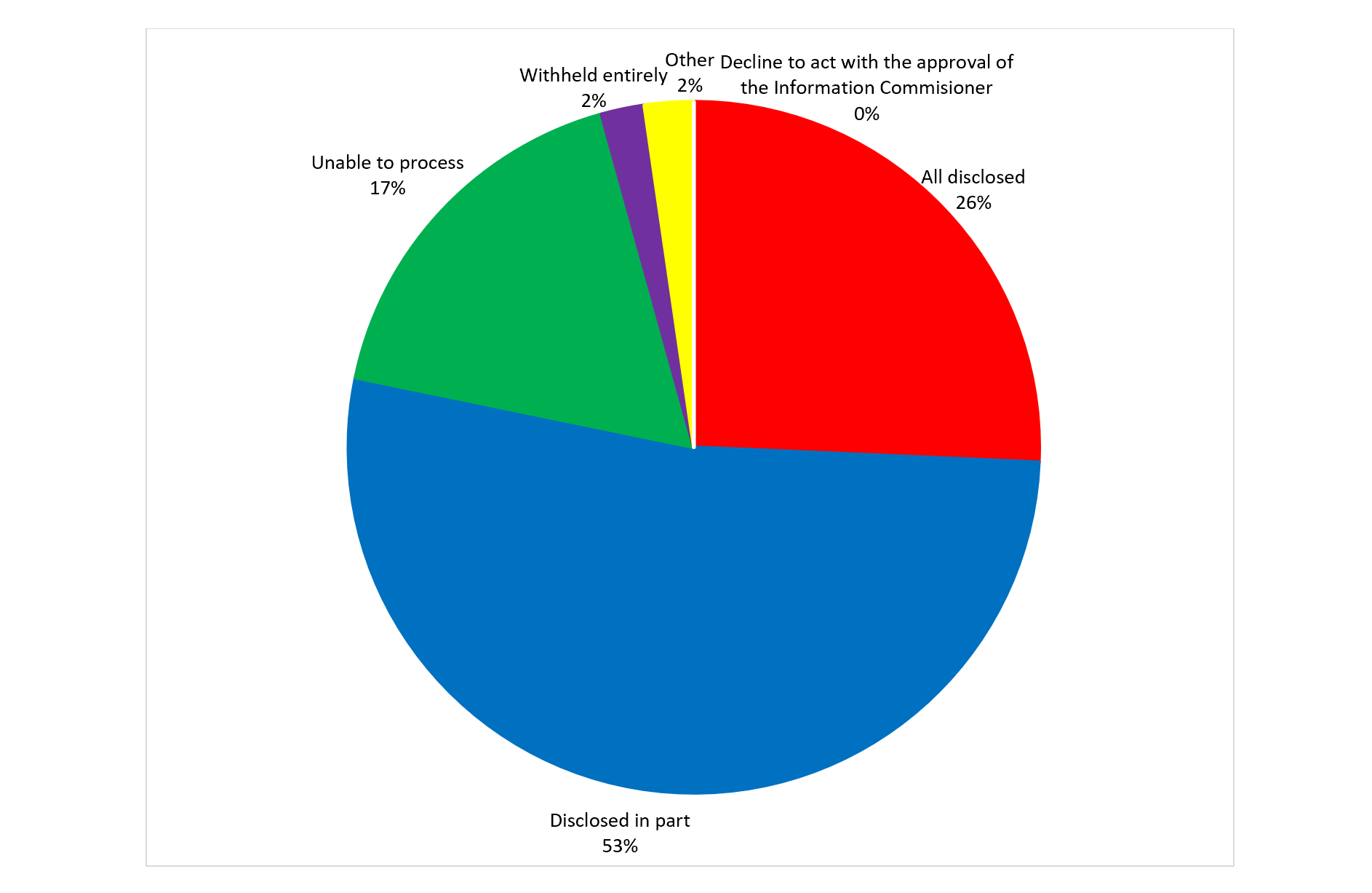
Figure 9 - Text version
| Disposition of closed requests | Requests as percentage |
|---|---|
| All disclosed | 26% |
| Disclosed in part | 53% |
| Unable to process | 17% |
| Withheld entirely | 2% |
| Other | 2% |
| Decline to act with the approval of the Information Commissioner | 0% |
Notes:
- “Unable to process” includes the categories “no records exist,”Footnote 3 “abandoned”Footnote 4 and “requests that could not be processed.”Footnote 5
- “Withheld entirely” includes the categories “all exempted” and “all excluded.”
- “Other” includes the categories “transferred,” “neither confirmed nor denied” and “treated informally.”
- In June 2019, the Access to Information Act was amended to enable institutions to seek the Information Commissioner’s approval to decline to act on requests that are vexatious, made in bad faith, or an abuse of the right of access. In the 2019 to 2020 fiscal year, one request was closed with the disposition ‘Decline to act with the approval of the Information Commissioner’.
Table 21 shows the disposition of ATI requests closed since 1983.
| Disposition of closed requests | Requests as percentage | Number of requests |
|---|---|---|
| Disclosed in part | 52.5 | 641,779 |
| All disclosed | 25.7 | 313,794 |
| All exempted | 1.5 | 18,151 |
| All excluded | 0.5 | 6,449 |
| No records exist | 4.6 | 56,653 |
| Abandoned | 5.1 | 61,958 |
| Transferred | 1.0 | 12,147 |
| Neither confirmed nor denied | 0.1 | 1,791 |
| Decline to act with the approval of the Information Commissioner | 0 | 1 |
| Treated informallytable 21 note a | 1.2 | 14,057 |
| Requests that could not be processedtable 21 note a | 7.8 | 94,706 |
| Total | 100 | 1,221,486 |
Table 21 Notes
|
||
Table 22 shows ATI requests closed since 1983, by the number of days required to close them.
| Closure time (including requests for which extensions were required) | Requests as percentage | Number of requests |
|---|---|---|
| 0 to 30 days | 58.7 | 716,540 |
| 31 to 60 days | 20.6 | 251,480 |
| 61 days or more | 20.8 | 253,466 |
| Total | 100 | 1,221,486 |
Table 23 shows the fees and costs associated with administering the Access to Information Act since 1983.
| Descriptions | Amount |
|---|---|
| Requests closed | 1,221,486 |
| Cost of operationsTable 23 note a | $1,349,384,830.17 |
| Average cost per closed requestTable 23 note b | $1,104.71 |
| Fees collected | $9,116,879.02 |
| Average fees collected per closed requestTable 23 note c | $7.46 |
| Fees waived or refunded | $3,727,433.94 |
| Average fees waived or refunded per closed requestTable 23 note d | $3.05 |
Table 23 Notes
|
|
Figure 10 shows ATI requests received and cost of Access to Information Act operations, from the 1983 to 1984 fiscal year to the 2019 to 2020 fiscal year.
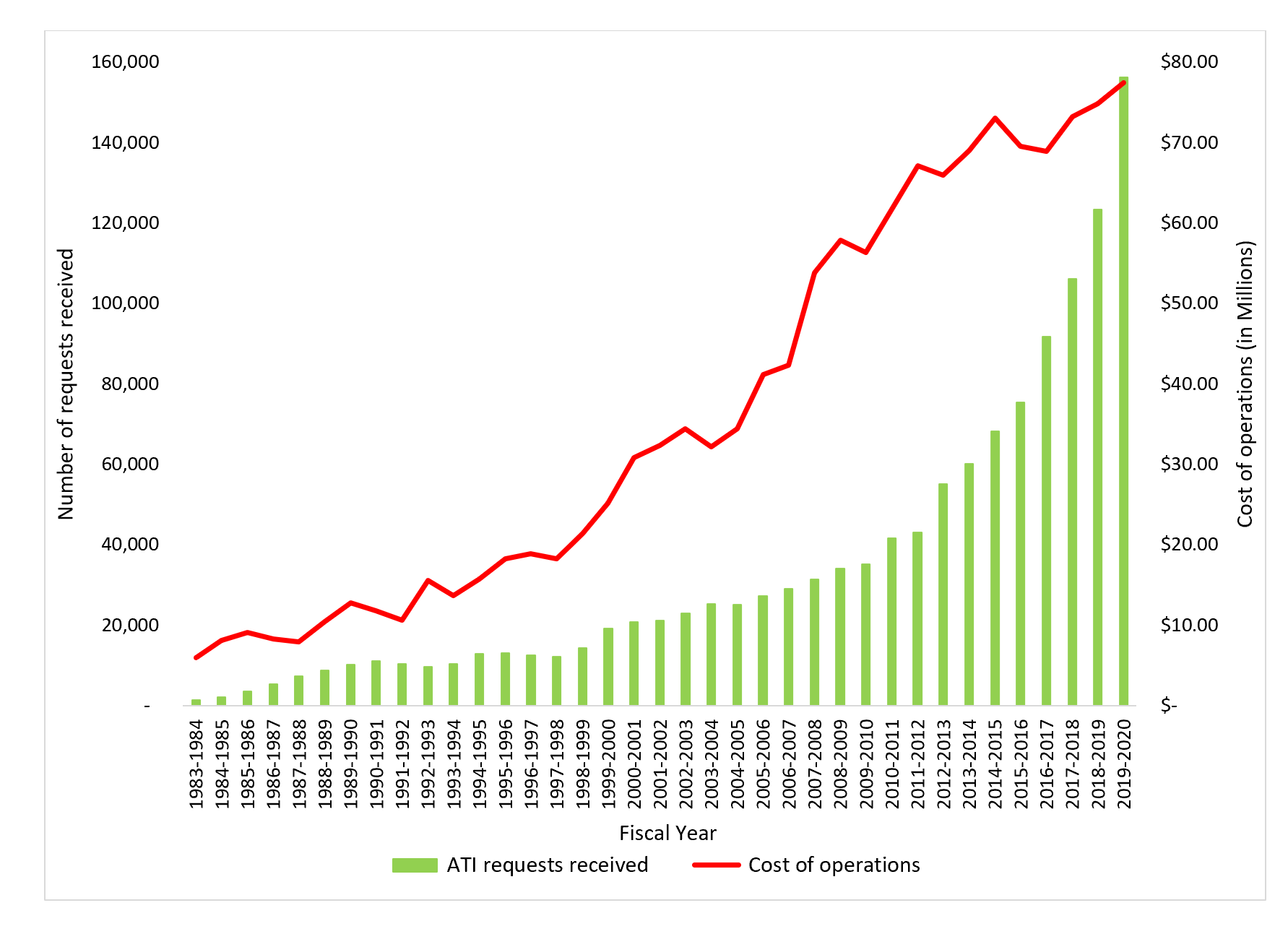
Figure 10 - Text version
| Year | Cost of operations (inflation adjusted)Figure 10 note * | ATI requests received |
|---|---|---|
| 1983-1984 | $5.95 | 1,513 |
| 1984-1985 | $8.14 | 2,229 |
| 1985-1986 | $9.08 | 3,606 |
| 1986-1987 | $8.31 | 5,450 |
| 1987-1988 | $7.91 | 7,301 |
| 1988-1989 | $10.42 | 8,853 |
| 1989-1990 | $12.78 | 10,234 |
| 1990-1991 | $11.84 | 11,093 |
| 1991-1992 | $10.66 | 10,387 |
| 1992-1993 | $15.54 | 9,729 |
| 1993-1994 | $13.73 | 10,422 |
| 1994-1995 | $15.75 | 12,861 |
| 1995-1996 | $18.25 | 13,124 |
| 1996-1997 | $18.89 | 12,476 |
| 1997-1998 | $18.24 | 12,206 |
| 1998-1999 | $21.43 | 14,340 |
| 1999-2000 | $25.17 | 19,294 |
| 2000-2001 | $30.87 | 20,789 |
| 2001-2002 | $32.39 | 21,265 |
| 2002-2003 | $34.48 | 22,977 |
| 2003-2004 | $32.18 | 25,234 |
| 2004-2005 | $34.47 | 25,207 |
| 2005-2006 | $41.17 | 27,269 |
| 2006-2007 | $42.36 | 29,182 |
| 2007-2008 | $53.86 | 31,487 |
| 2008-2009 | $57.94 | 34,041 |
| 2009-2010 | $56.37 | 35,154 |
| 2010-2011 | $61.79 | 41,641 |
| 2011-2012 | $67.11 | 43,194 |
| 2012-2013 | $65.98 | 55,145 |
| 2013-2014 | $69.05 | 60,105 |
| 2014-2015 | $73.10 | 68,193 |
| 2015-2016 | $69.54 | 75,387 |
| 2016-2017 | $68.95 | 91,880 |
| 2017-2018 | $73.29 | 106,255 |
| 2018‑2019 | $74.90 | 123,421 |
| 2019‑2020 | $77.47 | 156,222 |
Figure 10 Note
|
||
Privacy Act statistics for the 2019 to 2020 fiscal year
Requests under the Privacy Act
A total of 78,541 personal information requests under the Privacy Act were received in the 2019 to 2020 fiscal year, an increase of 5.3 percent from the 2018 to 2019 fiscal year. There was also a total of 27,346 personal information requests that were outstanding from the 2018 to 2019 fiscal year, an overall decrease of 1 percent from the outstanding requests from the previous fiscal year.
Of the 105,887 personal information requests that were either received in the 2019 to 2020 fiscal year or outstanding from the previous period, 70.1 percent were closed. This is a decrease of 3.2 percent from the 2018 to 2019 fiscal year: of the 102,137 requests that were either received in the 2018 to 2019 fiscal year or outstanding from the previous period, 73.3 percent were closed.
Table 24 shows the number of personal information requests received, closed and carried over for the 2019 to 2020 fiscal year.
| Personal information requests | Number of requests |
|---|---|
| Outstanding from 2018 to 2019 reporting periodtable 24 note a | 27,346 |
| Received during 2019 to 2020 reporting period | 78,541 |
| Total | 105,887 |
| Closed during 2019 to 2020 reporting period | 74,230 |
| Carried over to 2020 to 2021 reporting period | 31,657 |
Table 24 Notes
|
|
Figure 11 shows the number of personal information requests received, closed and carried over from the 2018 to 2019 fiscal year to 2019 to 2020 fiscal year.
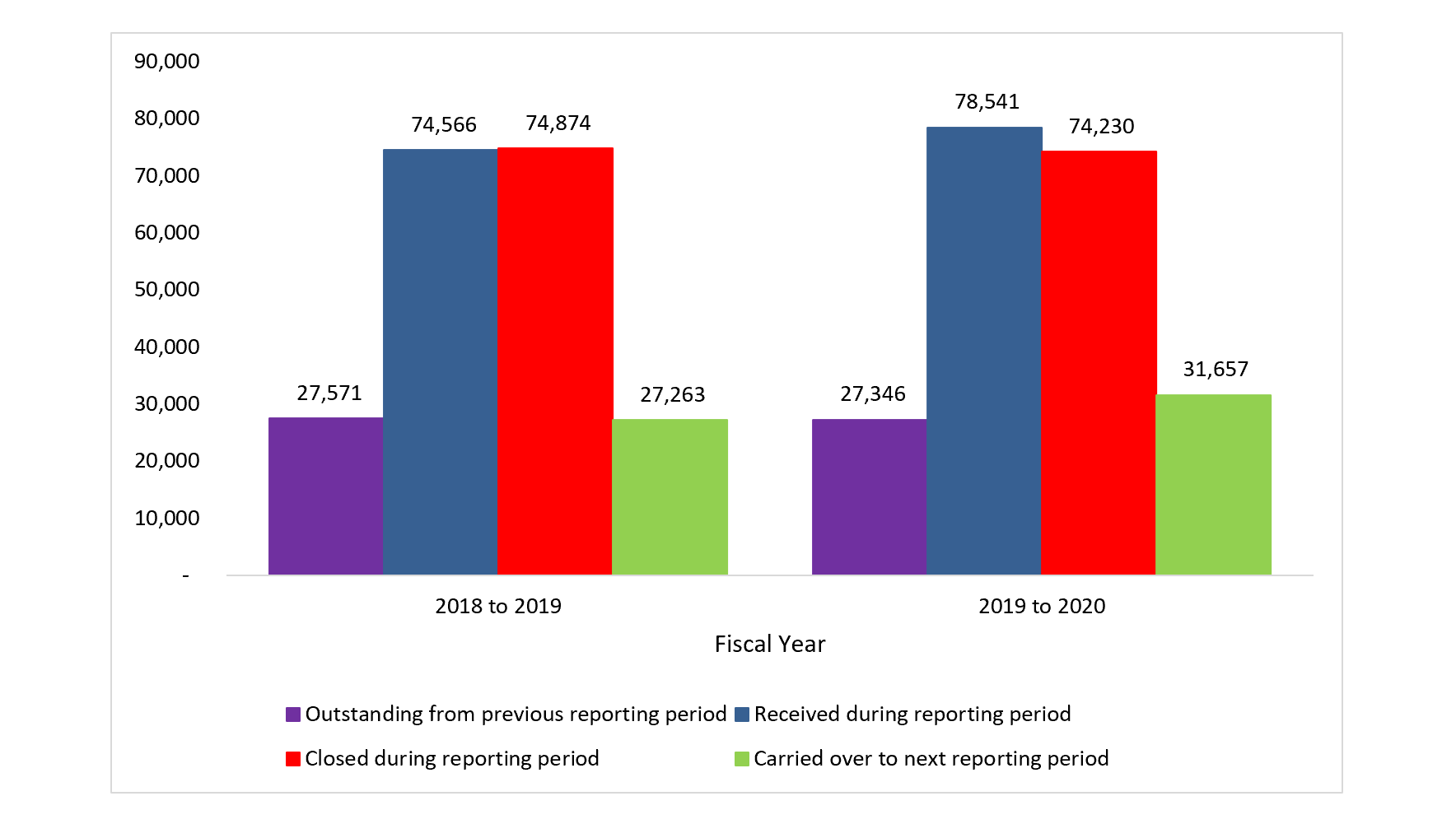
Figure 11 - Text version
| 2018 to 2019 | 2019 to 2020 | |
|---|---|---|
| Outstanding from previous reporting period | 27,571 | 27,346 |
| Received during reporting period | 74,566 | 78,541 |
| Closed during reporting period | 74,874 | 74,230 |
| Carried over to next reporting period | 27,263 | 31,657 |
Five government institutions received 75.1 percent of the 78,541 personal information requests received in the 2019 to 2020 fiscal year.
Figure 12 shows the proportion of personal informationrequests received by the five institutions that received the highest volume of requests, and all other government institutions, for the 2019 to 2020 fiscal year.
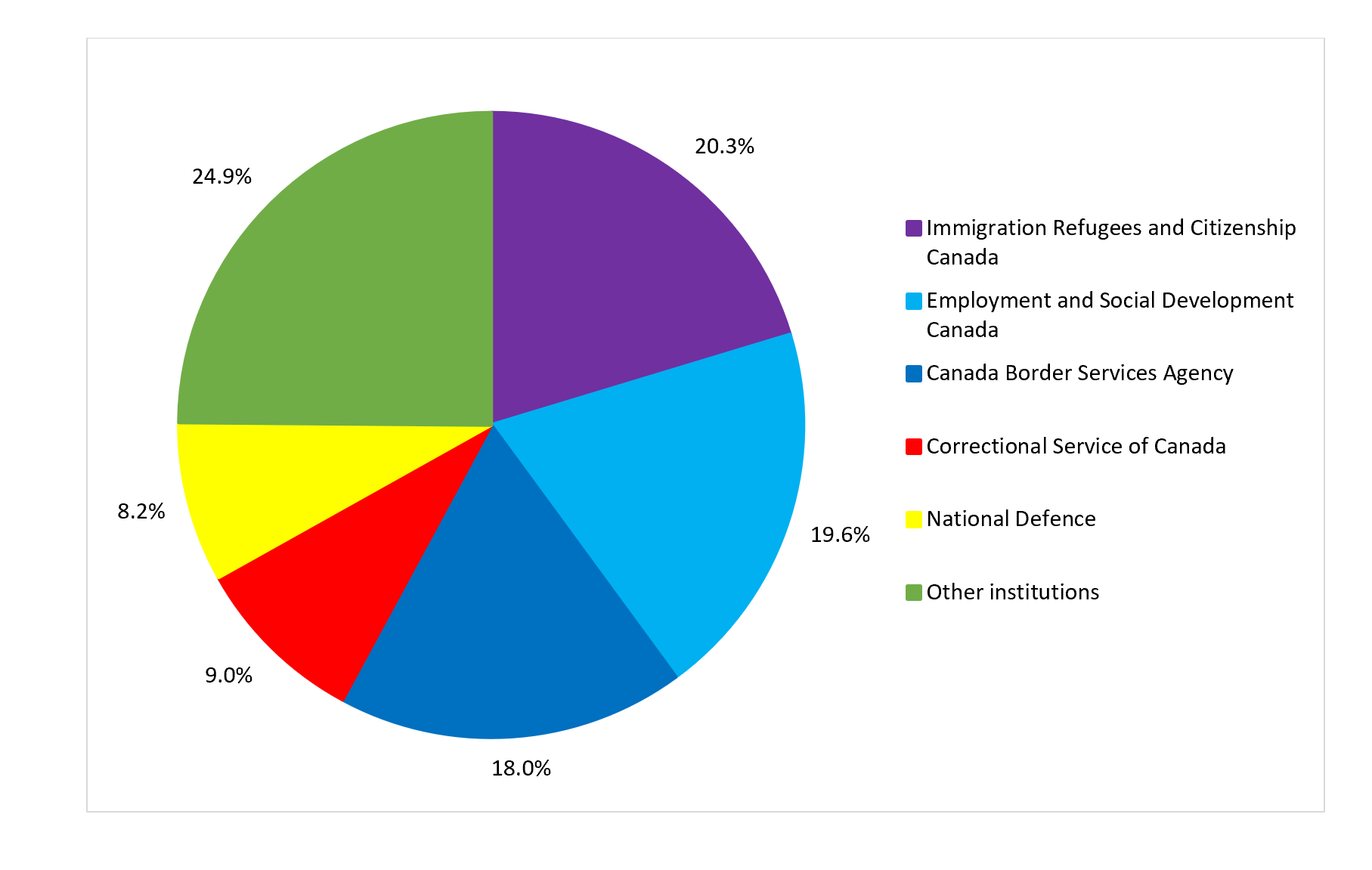
Figure 12 - Text version
| Immigration Refugees and Citizenship Canada | 20.3% |
|---|---|
| Employment and Social Development Canada | 19.6% |
| Canada Border Services Agency | 18.0% |
| Correctional Service of Canada | 9.0% |
| National Defence | 8.2% |
| Other institutions | 24.9% |
Table 25 shows the number of pages processed under the Privacy Act by the five institutions that received the highest volume of requests, and all other government institutions, for the 2019 to 2020 fiscal year.
| Rank | Name of institution | Number of requests received | Requests received as percentage | Pages processedtable 25 note a |
|---|---|---|---|---|
| 1 | Immigration Refugees and Citizenship Canada | 15,963 | 20.3 | 984,436 |
| 2 | Employment and Social Development Canada | 15,405 | 19.6 | 1,259,755 |
| 3 | Canada Border Services Agency | 14,102 | 18.0 | 547,551 |
| 4 | Correctional Service of Canada | 7,063 | 9.0 | 446,986 |
| 5 | National Defence | 6,475 | 8.2 | 2,381,632 |
| Other institutions | 19,533 | 24.9 | 3,661,773 | |
| Total | 78,541 | 100 | 9,282,133 | |
Table 25 Notes
|
||||
Timeliness
Of the 74,230 personal information requests closed in the 2019 to 2020 fiscal year, 78.9 percent were closed within the legislated timeline, including extensions. This is an increase of 2.3 percent from the 2018 to 2019 fiscal year.
Table 26 shows the number of personal information requests closed within legislated timelines, including extensions, in the 2018 to 2019 fiscal year and 2019 to 2020 fiscal year.
| Status of closed requests | Requests as percentage | Number of requests | ||
|---|---|---|---|---|
| 2018 to 2019 | 2019 to 2020 | 2018 to 2019 | 2019 to 2020 | |
| Closed within legislated timeline, including extensions | 76.6 | 78.9 | 57,334 | 58,599 |
| Closed beyond legislated timeline, including extensions | 23.4 | 21.1 | 17,540 | 15,631 |
| Total | 100 | 100 | 74,874 | 74,230 |
The percentage of personal requests closed within legislated timelines decreased by 1.5 percent over the last five fiscal years, from 80.4 percent in the 2015 to 2016 fiscal year to 78.9 percent in the 2019 to 2020 fiscal year.
Figure 13 shows personal information requests closed within legislated timelines, from the 2015 to 2016 fiscal year to the 2019 to 2020 fiscal year.
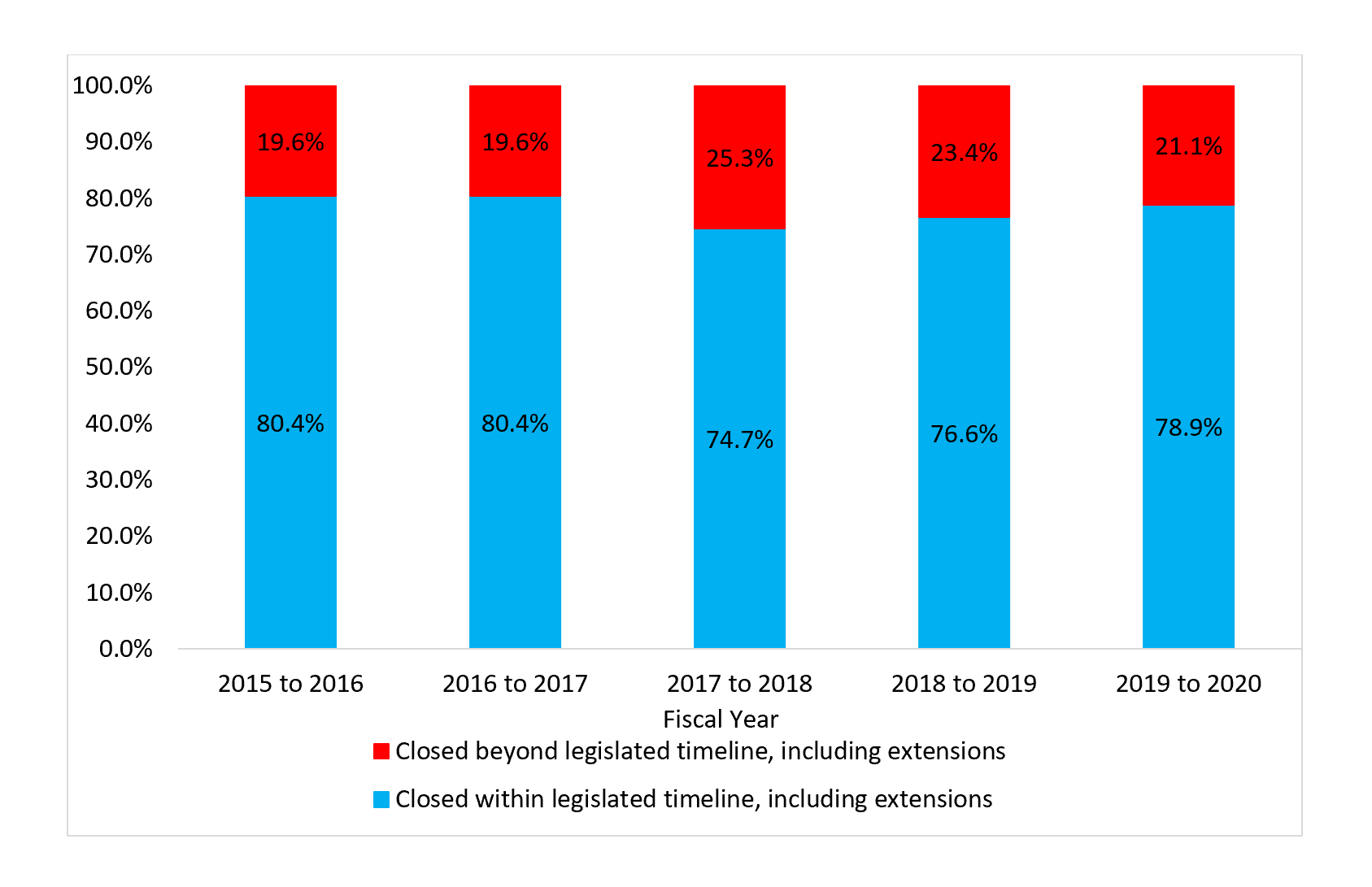
Figure 13 - Text version
| 2015 to 2016 | 2016 to 2017 | 2017 to 2018 | 2018 to 2019 | 2019 to 2020 | |
|---|---|---|---|---|---|
| Closed within legislated timeline, including extensions | 80.4% | 80.4% | 74.7% | 76.6% | 78.9% |
| Closed beyond legislated timeline, including extensions | 19.6% | 19.6% | 25.3% | 23.4% | 21.1% |
Another way to examine performance is to consider the number of institutions that meet the performance standard for personal information requests, which is to respond to 85 percent of requests within legislated timelines. Of the 99 institutions that closed personal information requests in the 2019 to 2020 fiscal year, 75 institutions met this standard, closing at least 85 percent of requests within legislated timelines. 24 institutions did not meet this standard, principally due to workload pressures within the organization. Of the 84 institutions that did not close any personal information requests in the 2019 to 2020 fiscal year, 83 institutions did not receive any requests and 1 institution received requests.
Table 27 shows the number of institutions that closed at least 85 percent of personal information requests within legislated timelines, from the 2015 to 2016 fiscal year to the 2019 to 2020 fiscal year.
| Number of institutions | 2015 to 2016 | 2016 to 2017 | 2017 to 2018 | 2018 to 2019 | 2019 to 2020 |
|---|---|---|---|---|---|
| Number of institutions that closed at least 85 percent of requests within legislated timelines | 78 | 70 | 74 | 66 | 75 |
| Number of institutions that closed fewer than 85 percent of requests within legislated timelines | 20 | 22 | 19 | 19 | 24 |
| Number of institutions that did not close any requests | 77 | 84 | 88 | 96 | 84 |
| Total | 175 | 176 | 181 | 181 | 183 |
Figure 14 shows the percentage of reporting institutions that closed at least 85 percent of personal information requests within legislated timelines, from the 2015 to 2016 fiscal year to the 2019 to 2020 fiscal year.
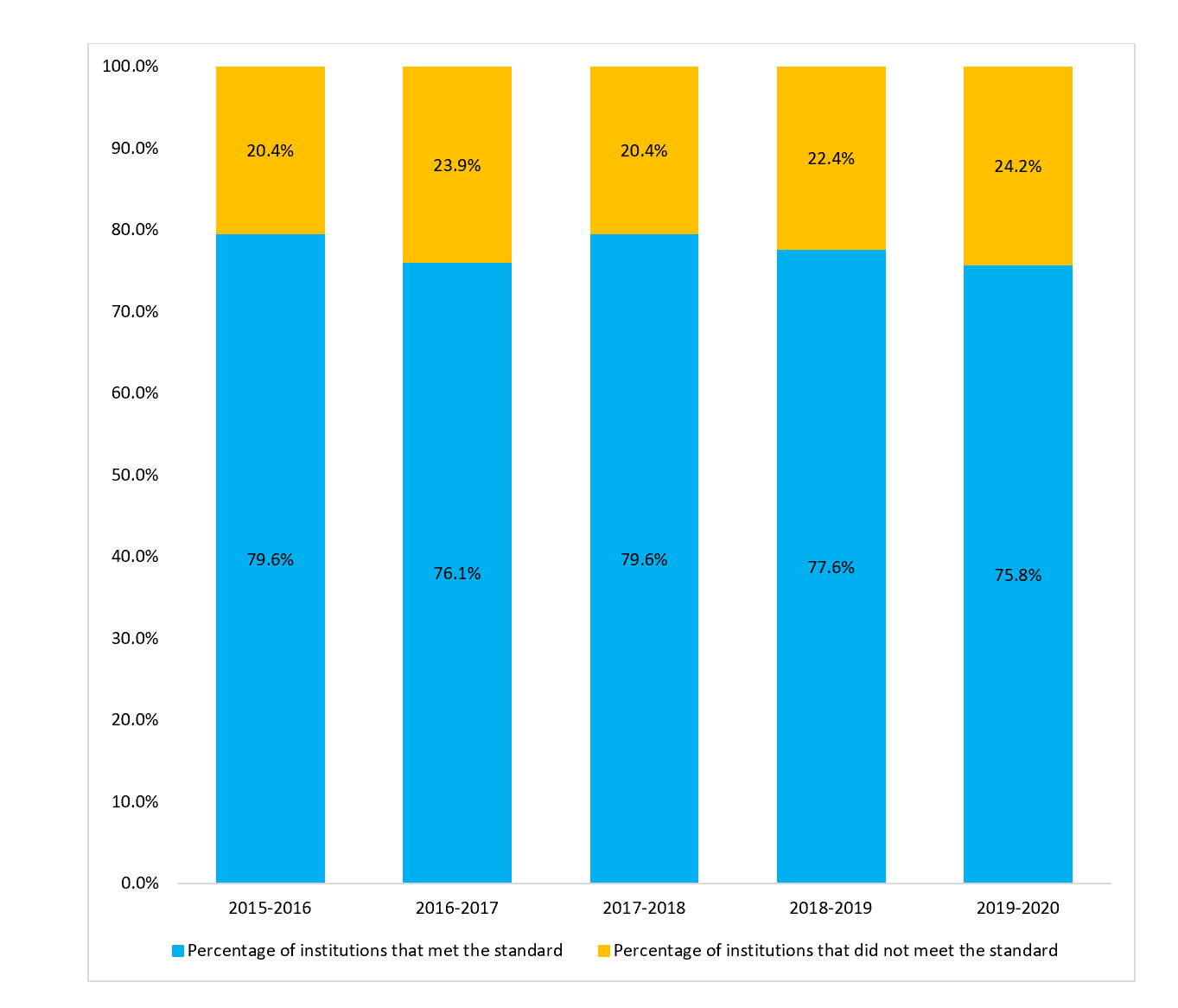
Figure 14 - Text version
| Based on 85% standard | 2015-2016 | 2016-2017 | 2017-2018 | 2018‑2019 | 2019‑2020 |
|---|---|---|---|---|---|
| Percentage of institutions that met the standard | 79.6% | 76.1% | 79.6% | 77.6% | 75.8% |
| Percentage of institutions that did not meet the standard | 20.4% | 23.9% | 20.4% | 22.4% | 24.2% |
Table 28 shows the disposition of personal informationrequests, and the time required to close these requests, for the 2019 to 2020 fiscal year.
| Disposition of requests (including requests for which extensions were required) | Closure timeTable 28 note a | |||||||
|---|---|---|---|---|---|---|---|---|
| 1 to 15 days | 16 to 30 days | 31 to 60 days | 61 to 120 days | 121 to 180 days | 181 to 365 days | More than 365 days | Total | |
| All disclosed | 3,372 | 11,998 | 3,658 | 602 | 194 | 279 | 301 | 20,404 |
| Disclosed in part | 5,301 | 15,389 | 7,774 | 2,324 | 824 | 1,548 | 2,397 | 35,557 |
| All exempted | 138 | 139 | 57 | 29 | 16 | 22 | 25 | 426 |
| All excluded | 1 | 2 | 1 | 1 | 1 | 0 | 0 | 6 |
| No records exist | 5,064 | 1,800 | 613 | 249 | 95 | 181 | 224 | 8,226 |
| Request abandonedTable 28 note b | 5,263 | 1,383 | 1,035 | 292 | 73 | 111 | 1,133 | 9,290 |
| Neither confirmed nor deniedTable 28 note c | 146 | 137 | 16 | 10 | 1 | 3 | 8 | 321 |
| Total | 19,285 | 30,848 | 13,154 | 3,507 | 1,204 | 2,144 | 4,088 | 74,230 |
| Total percentage | 26.0 | 41.6 | 17.7 | 4.7 | 1.6 | 2.9 | 5.5 | 100 |
Table 28 Notes
|
||||||||
Figure 15 shows the time required to close personal informationrequests from the 2015 to 2016 fiscal year to the 2019 to 2020 fiscal year
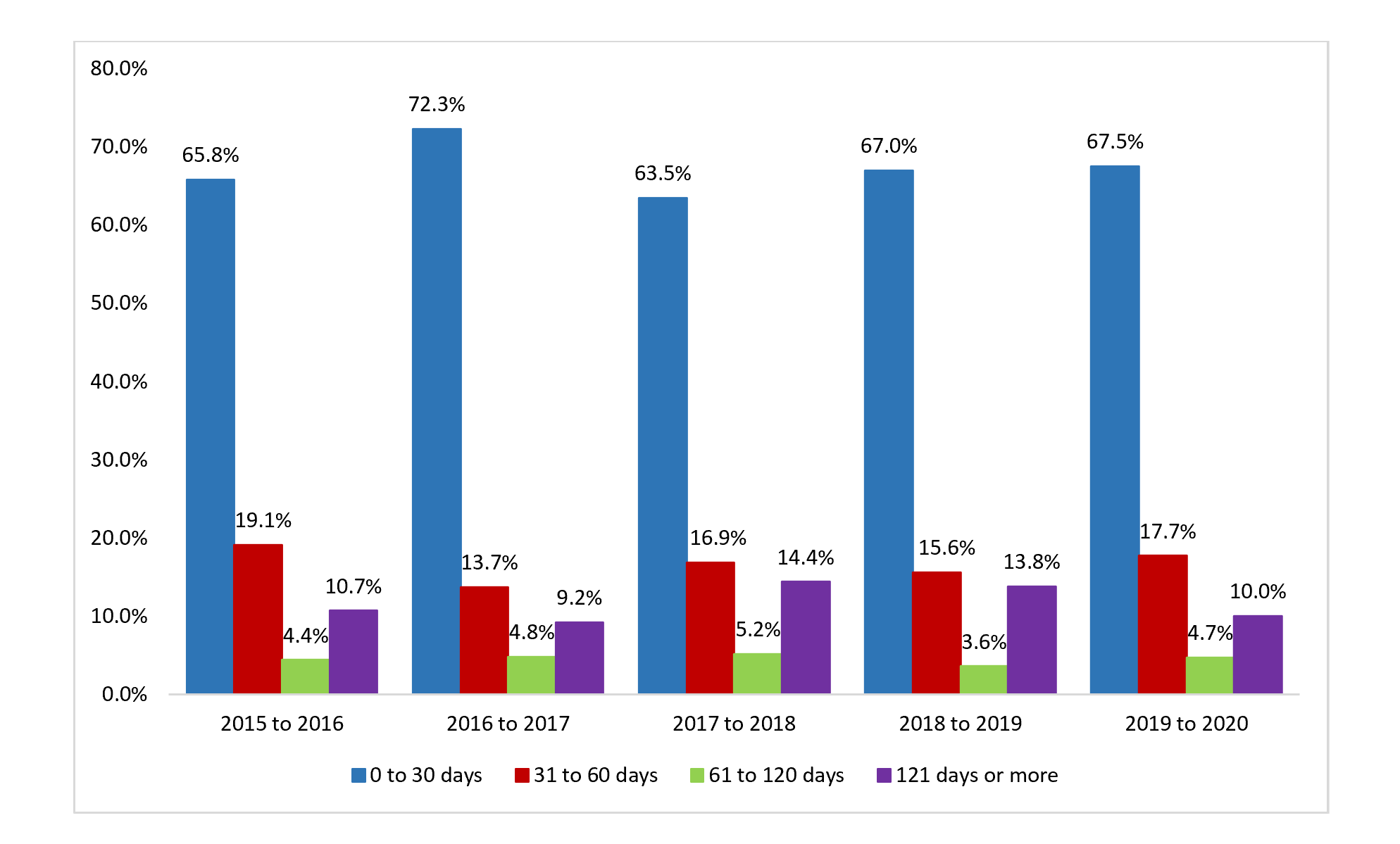
Figure 15 - Text version
| 2015 to 2016 | 2016 to 2017 | 2017 to 2018 | 2018 to 2019 | 2019 to 2020 | |
|---|---|---|---|---|---|
| 0 to 30 days | 65.8% | 72.3% | 63.5% | 67.0% | 67.5% |
| 31 to 60 days | 19.1% | 13.7% | 16.9% | 15.6% | 17.7% |
| 61 to 120 days | 4.4% | 4.8% | 5.2% | 3.6% | 4.7% |
| 121 days or more | 10.7% | 9.2% | 14.4% | 13.8% | 10.0% |
Table 29 shows the principal reason that personal information requests were closed beyond the legislated timeline for the 2019 to 2020 fiscal year
| Principal reason | Total number of requests closed beyond the legislated timelines including extensions |
|---|---|
| Workload | 14,078 |
| External consultation | 148 |
| Internal consultation | 215 |
| OtherTable 29 note a | 1,190 |
| Total | 15,631 |
Table 29 Notes
Note: requests that were closed neither in the initial 30-day legislated timeframe nor within the timeframe covered by an extension. |
|
Of the 15,631 personal information requests closed beyond the legislated timeline, 73.4 percent were past the timeline with no extension taken. This is a decrease of 11.9 percent from the 2018 to 2019 fiscal year.
Table 30 shows the number of personal informationrequests that were closed beyond the legislated timeline in the 2019 to 2020 fiscal year, by number of days past the timeline.
| Number of days past legislated timeline | Number of requests past legislated timeline where no extension was taken | Number of requests past legislated timeline where an extension was taken | Total requests closed beyond the legislated timeline including extensions | Total as percentage |
|---|---|---|---|---|
| 1 to 15 days | 4,589 | 547 | 5,136 | 32.9 |
| 16 to 30 days | 570 | 305 | 875 | 5.6 |
| 31 to 60 days | 926 | 445 | 1,371 | 8.8 |
| 61 to 120 days | 753 | 511 | 1,264 | 8.1 |
| 121 to 180 days | 832 | 307 | 1,139 | 7.3 |
| 181 to 365 days | 1,793 | 586 | 2,379 | 15.2 |
| More than 365 days | 2,016 | 1,451 | 3,467 | 22.2 |
| Total | 11,479 | 4,152 | 15,631 | 100 |
Disposition
Records were disclosed either in full or in part for 75.4 percent of closed personal information requests. This is an increase of 1.2 percent from the 2018 to 2019 fiscal year.
Table 31 shows the disposition of closed personal information requests for the 2018 to 2019 fiscal year to the 2019 to 2020 fiscal year.
| Disposition of closed requests | Requests as percentage | Number of requests | ||
|---|---|---|---|---|
| 2018 to 2019 | 2019 to 2020 | 2018 to 2019 | 2019 to 2020 | |
| All disclosed | 27.5 | 27.5 | 20,567 | 20,404 |
| Disclosed in part | 46.8 | 47.9 | 35,021 | 35,557 |
| All exempted | 0.5 | 0.6 | 397 | 426 |
| All excluded | 0.0 | 0.0 | 14 | 6 |
| No records exist | 11.8 | 11.1 | 8,812 | 8,226 |
| Request abandoned | 13.0 | 12.5 | 9,712 | 9,290 |
| Neither confirmed nor denied | 0.5 | 0.4 | 351 | 321 |
| Total | 100 | 100 | 74,874 | 74,230 |
Figure 16 shows the disposition of closed personal information requests for the 2018 to 2019 fiscal year to the 2019 to 2020 fiscal year.
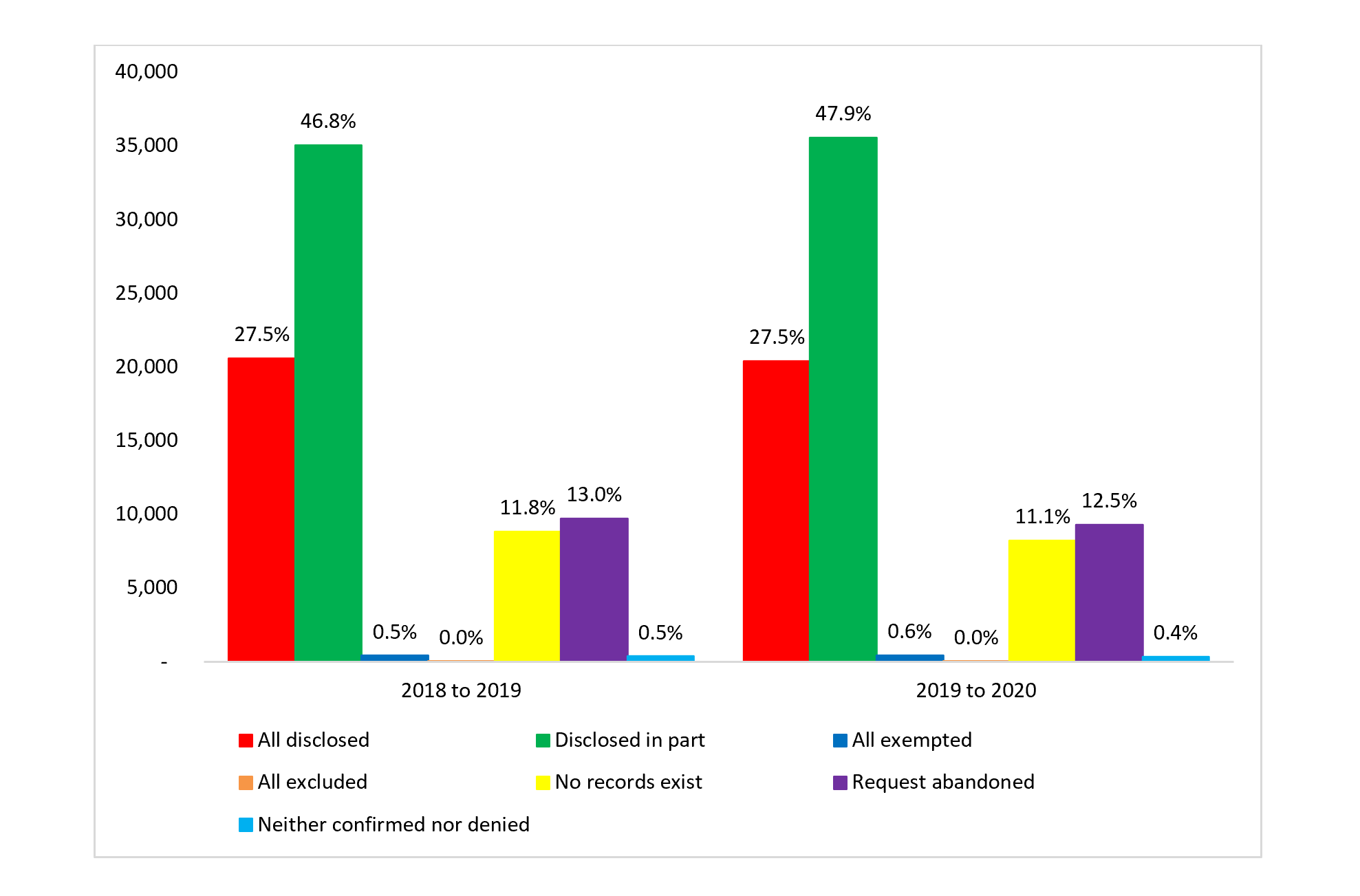
Figure 16 - Text version
| 2018‑19 % | 2019‑20 % | |
|---|---|---|
| All disclosed | 27.5% | 27.5% |
| Disclosed in part | 46.8% | 47.9% |
| All exempted | 0.5% | 0.6% |
| All excluded | 0.0% | 0.0% |
| No records exist | 11.8% | 11.1% |
| Request abandoned | 13.0% | 12.5% |
| Neither confirmed nor denied | 0.5% | 0.4% |
Complexity
In the 2019 to 2020 fiscal year, government institutions processed about 9.3 million pages for closed personal information requests.
Government institutions undertook consultations with parties outside the federal government in 1.5 percent of all closed personal information requests.
Table 32 shows the number of relevant pages processed and disclosed in response to personal information requests closed in the 2018 to 2019 fiscal year and the 2019 to 2020 fiscal year, by manner of disposition.
| Number of pages processed | Number of pages disclosed | Number of requestsTable 32 note a | ||||
|---|---|---|---|---|---|---|
| 2018 to 2019 | 2019 to 2020 | 2018 to 2019 | 2019 to 2020 | 2018 to 2019 | 2019 to 2020 | |
| Total | 9,338,210 | 9,282,133 | 7,724,545 | 7,530,019 | 65,711 | 66,004 |
Table 32 Notes
Note: Institutions subject to the Privacy Act may receive and process duplicate records and, in the end, release a single copy of the duplicates to the requester. |
||||||
Figure 17 shows the number of pages processed in response to closed personal information requests from fiscal year 2015 to 2016 to fiscal year 2019 to 2020.
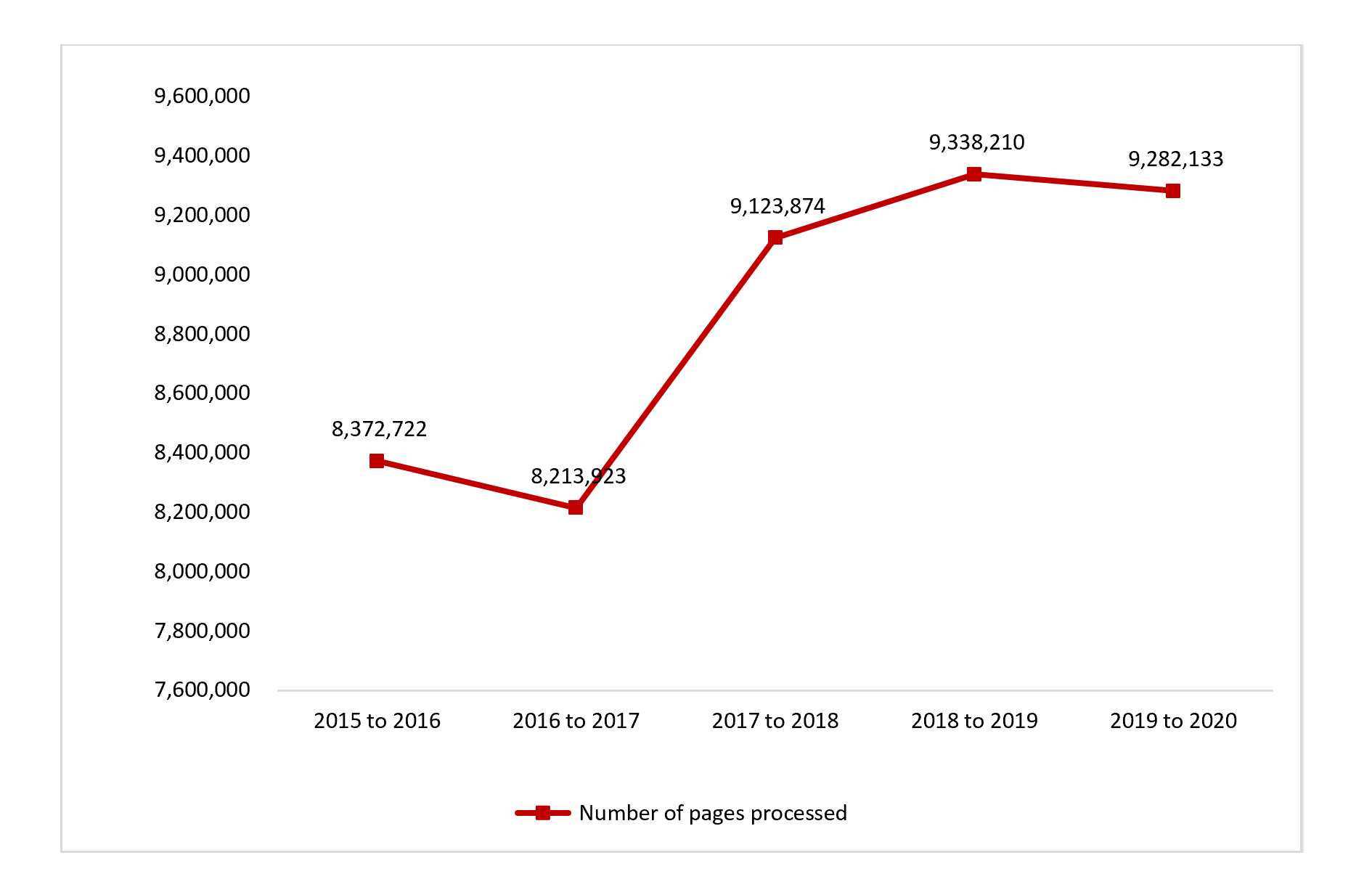
Figure 17 - Text version
| 2015 to 2016 | 2016 to 2017 | 2017 to 2018 | 2018 to 2019 | 2019 to 2020 | |
|---|---|---|---|---|---|
| Number of pages processed | 8,372,722 | 8,213,923 | 9,123,874 | 9,338,210 | 9,282,133 |
| Disposition | Consultation required | Legal advice sought | Interwoven informationTable 33 note a | OtherTable 33 note b | Total |
|---|---|---|---|---|---|
| All disclosed | 182 | 1 | 56 | 254 | 493 |
| Disclosed in part | 850 | 29 | 9,404 | 118 | 10,401 |
| All exempted | 9 | 4 | 6 | 1 | 20 |
| All excluded | 0 | 0 | 0 | 1 | 1 |
| Request abandoned | 35 | 4 | 105 | 55 | 199 |
| Neither confirmed nor denied | 24 | 3 | 2 | 0 | 29 |
| Total | 1,100 | 41 | 9,573 | 429 | 11,143 |
Table 33 Notes
|
|||||
Consultations
The number of requests for consultations between federal government institutions decreased by 4.9 percent from the 2018 to 2019 fiscal year. The number of pages to review decreased by 1.5 percent.
Table 34 shows the number of personal information requests for consultation in the 2018 to 2019 fiscal year to the 2019 to 2020 fiscal year between government institutions and the number of pages reviewed in connection with those requests.
| Consultations | Number of requests for consultation | Number of pages to review | ||
|---|---|---|---|---|
| 2018 to 2019 | 2019 to 2020 | 2018 to 2019 | 2019 to 2020 | |
| Received during reporting period | 392 | 378 | 18,774 | 16,869 |
| Outstanding from the previous reporting period | 38 | 31 | 36,307 | 37,386 |
| Total | 430 | 409 | 55,081 | 54,255 |
| Closed during the reporting period | 399 | 382 | 18,126 | 50,091 |
| Pending at the end of the reporting period | 31 | 27 | 36,955 | 4,164 |
Table 35 shows, by recommendation, the number of personal information requests for consultation that were closed within particular timeframes in fiscal year 2019 to 2020.
| Recommendation | Number of days required to close consultation requests | |||||||
|---|---|---|---|---|---|---|---|---|
| 1 to 15 days | 16 to 30 days | 31 to 60 days | 61 to 120 days | 121 to 180 days | 181 to 365 days | More than 365 days | Total | |
| Disclose entirely | 90 | 38 | 12 | 1 | 0 | 0 | 1 | 142 |
| Disclose in part | 103 | 45 | 36 | 9 | 2 | 2 | 2 | 199 |
| Exempt entirely | 9 | 4 | 3 | 5 | 1 | 0 | 0 | 22 |
| Exclude entirely | 0 | 0 | 0 | 0 | 0 | 0 | 0 | 0 |
| Consult other institutionTable 35 note a | 2 | 2 | 0 | 0 | 0 | 0 | 0 | 4 |
| Other | 7 | 1 | 4 | 0 | 0 | 0 | 3 | 15 |
| Total | 211 | 90 | 55 | 15 | 3 | 2 | 6 | 382 |
Table 35 Notes
|
||||||||
Extensions
92.8 percent of all extensions taken for closed requests cited paragraph 15(a)(i) of the Privacy Act as a reason for the extension, relating to interference with government operations.
Table 36 shows the number of personal informationrequests that were closed in fiscal year 2019 to 2020 where extensions were invoked, by length of extension.
| Length of extensionTable 36 note a | 15(a)(i): Interference with operations | 15(a)(ii): Consultation | 15(b): Translation purposes or conversion | Total | |||||
|---|---|---|---|---|---|---|---|---|---|
| Further review required to determine exemptions | Large volume of pages | Large volume of requests | Documents are difficult to obtain | Cabinet Confidence (Section 70)Table 36 note b | External | Internal | |||
| 1 to 15 days | 4 | 3 | 7 | 2 | 0 | 1 | 6 | 0 | 23 |
| 16 to 30 days | 105 | 798 | 10,530 | 94 | 2 | 270 | 596 | 19 | 12,414 |
| 31 days or greater | N/A | N/A | N/A | N/A | N/A | N/A | N/A | 1 | 1 |
| Total | 109 | 801 | 10,537 | 96 | 2 | 271 | 602 | 20 | 12,438 |
Table 36 Notes
|
|||||||||
ExemptionsFootnote 6
The tables that follow show the number of personal information requests closed in the 2019 to 2020 fiscal year in which specific exemptions under the Privacy Act were invoked.
| Provision | Number of requests |
|---|---|
| 18(2) | 232 |
| Provision | Number of requests |
|---|---|
| 19(1)(a) | 1,220 |
| 19(1)(b) | 34 |
| 19(1)(c) | 912 |
| 19(1)(d) | 610 |
| 19(1)(e) | 0 |
| 19(1)(f) | 0 |
| Provision | Number of requests |
|---|---|
| 20 | 5 |
| Provision | Number of requests |
|---|---|
| 21 | 5,745 |
| Provision | Number of requests |
|---|---|
| 22(1)(a)(i) | 1,569 |
| 22(1)(a)(ii) | 399 |
| 22(1)(a)(iii) | 20 |
| 22(1)(b) | 5,599 |
| 22(1)(c) | 592 |
| 22(2) | 3 |
| 22.1 | 16 |
| 22.2 | 1 |
| 22.3 | 8 |
| 22.4 | 0 |
| Provision | Number of requests |
|---|---|
| 23(a) | 6 |
| 23(b) | 0 |
| Provision | Number of requests |
|---|---|
| 24(a) | 4 |
| 24(b) | 168 |
| Provision | Number of requests |
|---|---|
| 25 | 811 |
| Provision | Number of requests |
|---|---|
| 26 | 29,074 |
| Provision | Number of requests |
|---|---|
| 27 | 958 |
| 27.1 | 2 |
| Provision | Number of requests |
|---|---|
| 28 | 25 |
ExclusionsFootnote 7
The tables that follow show the number of personal information requests closed in the 2019 to 2020 fiscal year in which specific exclusions under the Privacy Act were invoked.
| Provision | Number of requests |
|---|---|
| 69(1)(a) | 16 |
| 69(1)(b) | 0 |
| Provision | Number of requests |
|---|---|
| 69.1 | 1 |
| Provision | Number of requests |
|---|---|
| 70(1) | 1 |
| 70(1)(a) | 2 |
| 70(1)(b) | 0 |
| 70(1)(c) | 1 |
| 70(1)(d) | 0 |
| 70(1)(e) | 1 |
| 70(1)(f) | 0 |
| Provision | Number of requests |
|---|---|
| 70.1 | 0 |
Costs
The cost to administer the Government of Canada’s privacy program increased by 13.6 percent to about $55 million in the 2019 to 2020 fiscal year, with the average cost per closed request increasing by 14.6 percent to about $741 per request.
Table 39 shows the costs associated with administering the Privacy Act for fiscal year 2018 to 2019 and fiscal year 2019 to 2020.
| Description of costs | Amount | |
|---|---|---|
| 2018 to 2019 | 2019 to 2020 | |
| Cost of institutions’ operationsTable 39 note a | $47,995,307 | $54,607,942 |
| Cost of ATIP Online Request ServiceTable 39 note b | $419,853 | $384,191 |
| Total | $48,415,160 | $54,992,133 |
| Requests closed | 74,874 | 74,230 |
| Average cost per closed requestTable 39 note c | $646.62 | $740.83 |
| Pages processed | 9,338,210 | 9,282,133 |
| Average cost per page processed | $5.18 | $5.92 |
Table 39 Notes
|
||
Disclosures under subsections 8(2) and 8(5) of the Privacy Act
Subsection 8(1) of the Privacy Act states that “personal information under the control of a government institution shall not, without the consent of the individual to whom it relates, be disclosed by the institution except in accordance with this section.” Subsection 8(2) of the Act, subject to other Acts of Parliament, provides for exceptions where it would be possible for government institutions to disclose personal information without consent. Subsection 8(5) of the Act requires institutions to notify the Privacy Commissioner in writing of any disclosure of personal information made pursuant to paragraph 8(2)(m) of the Act. These notifications should be done prior to the disclosure where reasonably practical or in any other cases forthwith.
Table 40 shows the number of disclosures made under paragraphs 8(2)(e) and 8(2)(m) and subsection 8(5) of the Privacy Act in the 2019 to 2020 fiscal year.
| Paragraph 8(2)(e)Table 40 note a | Paragraph 8(2)(m)Table 40 note b | Subsection 8(5) | Total |
|---|---|---|---|
| 5,686 | 230 | 180 | 6,096 |
Table 40 Notes
|
|||
Requests for correction of personal information and notations
Subsection 12(2) of the Privacy Act provides individuals with the right to request that government institutions correct personal information under their control when the individual believes that it may contain errors or omissions. Alternatively, the individual may request that government institutions attach a notation to the information to reflect any corrections that were requested but not made.
Where the information has been disclosed to other individuals or organizations, government institutions are also required to advise them of the correction or notation.
Table 41 shows the number of requests for correction of personal information made to government institutions in the 2019 to 2020 fiscal year.
| Disposition of received requests | Amount |
|---|---|
| Requests for correction accepted | 21 |
| Notations attached | 42 |
| Total | 63 |
Privacy impact assessments
Privacy impact assessments (PIAs) provide a framework to ensure that privacy is considered throughout the design or redesign of programs or service delivery. PIAs identify the extent to which proposals comply with all appropriate statutes, assist managers and decision makers in avoiding or mitigating privacy risks, and promote informed policy, program and system design choices.
Completed PIAs must be submitted to the Treasury Board of Canada Secretariat, as well as to the Office of the Privacy Commissioner.
Table 42 shows the number of PIAs completed by government institutions in the 2019 to 2020 fiscal year.
| Privacy impact assessments | Amount |
|---|---|
| Number of PIAs completedTable 42 note a | 77 |
Table 42 Notes
|
|
Personal information banks
Personal information banks (PIBs) are descriptions of personal information held by government institutions. The Privacy Act requires that PIBs describe all personal information about individuals that is organized and retrievable by a person’s name or by an identifying number, symbol or other particular assigned only to that person. PIBs must include personal information that has been or is being used, or is available for use, to support a program or activity.
Institution-specific PIBs describe personal information contained in the records relating to the institution-specific programs of a government institution.
Standard PIBs describe personal information found in records created, collected and maintained by most government institutions to support common internal programs and activities, such as communications, travel and employment. They are created by the Treasury Board of Canada Secretariat and government institutions can register against them.
Central PIBs describe personal information about members of the general public, as well as current and former employees from all or several government institutions. They are maintained by central government departments and agencies.
Table 43 shows the number of new PIBs, newly registered PIBs and the number of institutions registering new PIBs.
| Personal information banks | Amount |
|---|---|
| Number of new institution-specific PIBs registered | 5 |
| Number of times government institutions registered against standard PIBsTable 43 note a | 20 |
| Number of central PIBs registered | 0 |
| Total number of new PIBs registered | 25 |
| Number of government institutions registering new PIBs | 5 |
Table 43 Notes
|
|
Table 44 shows the number of PIBs active, created, terminated and modified during the 2019 to 2020 fiscal year.
| Personal information banks | Amount |
|---|---|
| Active | 2,250 |
| Created | 46 |
| Terminated | 15 |
| Modified | 110 |
Material Privacy Breaches
A breach is deemed a “material privacy breach” if the breach involves sensitive personal information and could reasonably be expected to cause serious injury or harm to the individual and/or involves a large number of affected individuals. Section 4 of the Guidelines for Privacy Breaches requires institutions to establish a process for the mandatory reporting of material privacy breaches to the Office of the Privacy Commissioner (OPC) and the Treasury Board of Canada Secretariat (TBS).
Table 45 shows the number of material privacy breaches reported to the Treasury Board of Canada Secretariat (TBS) and the Office of the Privacy Commissioner of Canada (OPC) in the 2019 to 2020 fiscal year.
| Material Privacy Breaches | Amount |
|---|---|
| Number of material privacy breaches reported to TBS | 326 |
| Number of material privacy breaches reported to OPC | 326Table 45 note a |
Table 45 Notes
|
|
Privacy Act requests since 1983
The statistics that follow reflect the best available data since 1983. The categories have been adjusted in some cases in order to compare data across the years.
Table 46 shows the number ofpersonal informationrequests received and closed since 1983.
| Requests under the Privacy Act | Number of requests |
|---|---|
| Requests received | 1,797,553 |
| Requests closed | 1,765,744 |
Figure 18 shows the disposition of personal information requests closed since 1983.
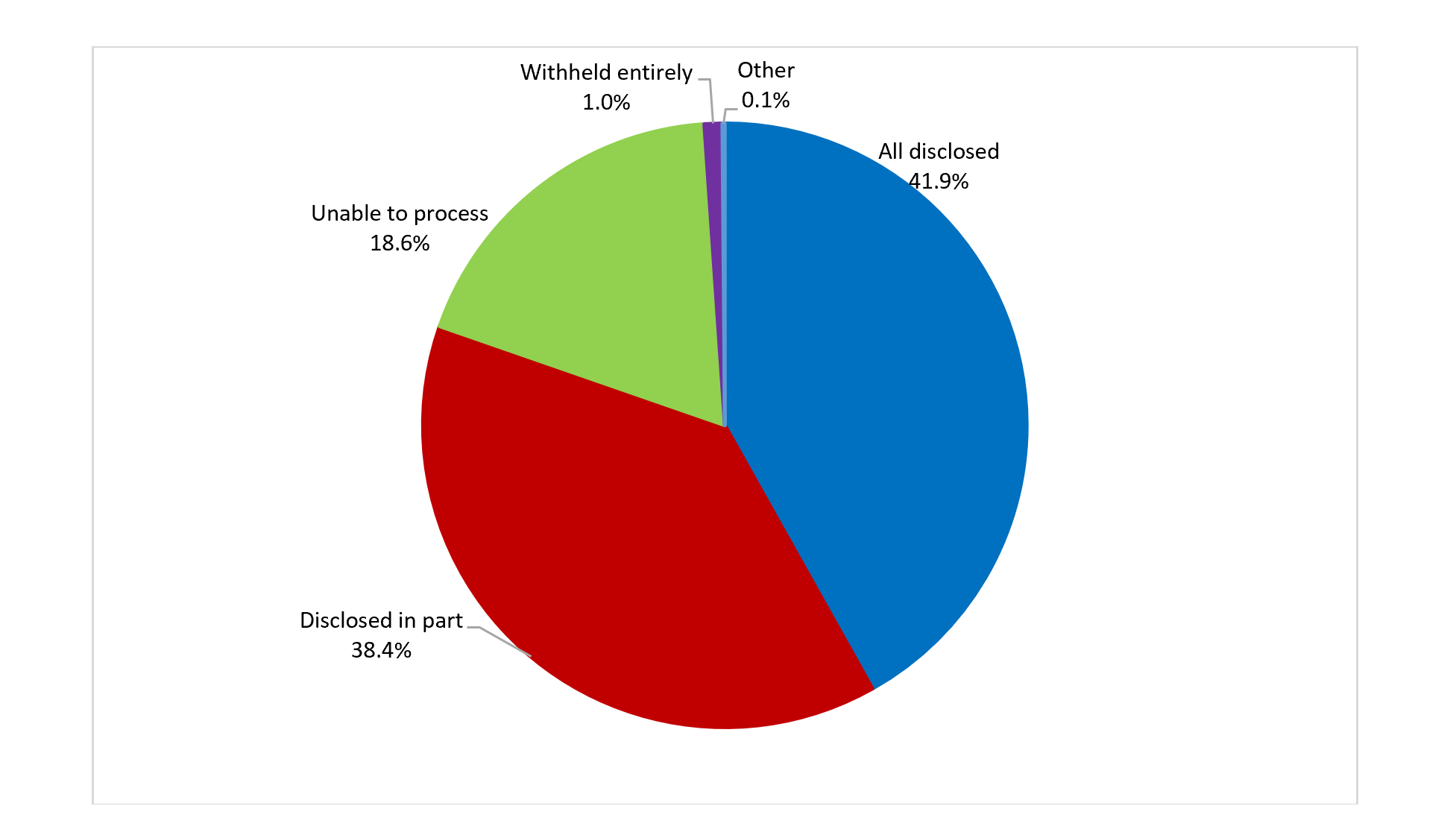
Figure 18 - Text version
| Disposition of closed Privacy Act requests since 1983 | 2019‑20 |
|---|---|
| All disclosed | 41.9% |
| Disclosed in part | 38.4% |
| Unable to process | 18.6% |
| Withheld entirely | 1.0% |
| Other | 0.1% |
Notes:
- “Unable to process” includes the categories “no records exist,”Footnote 8 “transferred,”Footnote 9 “abandoned”Footnote 10 and “requests that could not be processed.”Footnote 11
- “Withheld entirely” includes categories “all exempted” and “all excluded.”
- “Other” consists of the category “neither confirmed nor denied.”
Table 47 shows the disposition of personal information requests closed since 1983.
| Disposition of closed requests | Requests as percentage | Number of requests |
|---|---|---|
| All disclosed | 41.9 | 739,336 |
| Disclosed in part | 38.4 | 678,853 |
| All exempted | 0.9 | 16,177 |
| All excluded | 0.0 | 680 |
| No records exist | 4.8 | 84,328 |
| Abandoned | 6.2 | 110,189 |
| Neither confirmed nor denied | 0.1 | 2,328 |
| TransferredTable 47 note a | 1.8 | 32,188 |
| Requests that could not be processedTable 47 note a | 5.8 | 101,665 |
| Total | 100 | 1,765,744 |
Table 47 Notes
|
||
Table 48 shows the costs associated with administering the Privacy Act since 1983.
| Description of cost of operations | Amount |
|---|---|
| Requests closed | 1,765,744 |
| Cost of operationsTable 48 note a | $851,521,667.32 |
| Average cost per closed requestTable 48 note b | $482.25 |
Table 48 Notes
|
|
Figure 19 shows personal information requests received and cost of Privacy Act operations, from the 1983 to 1984 fiscal year to the 2019 to 2020 fiscal year.
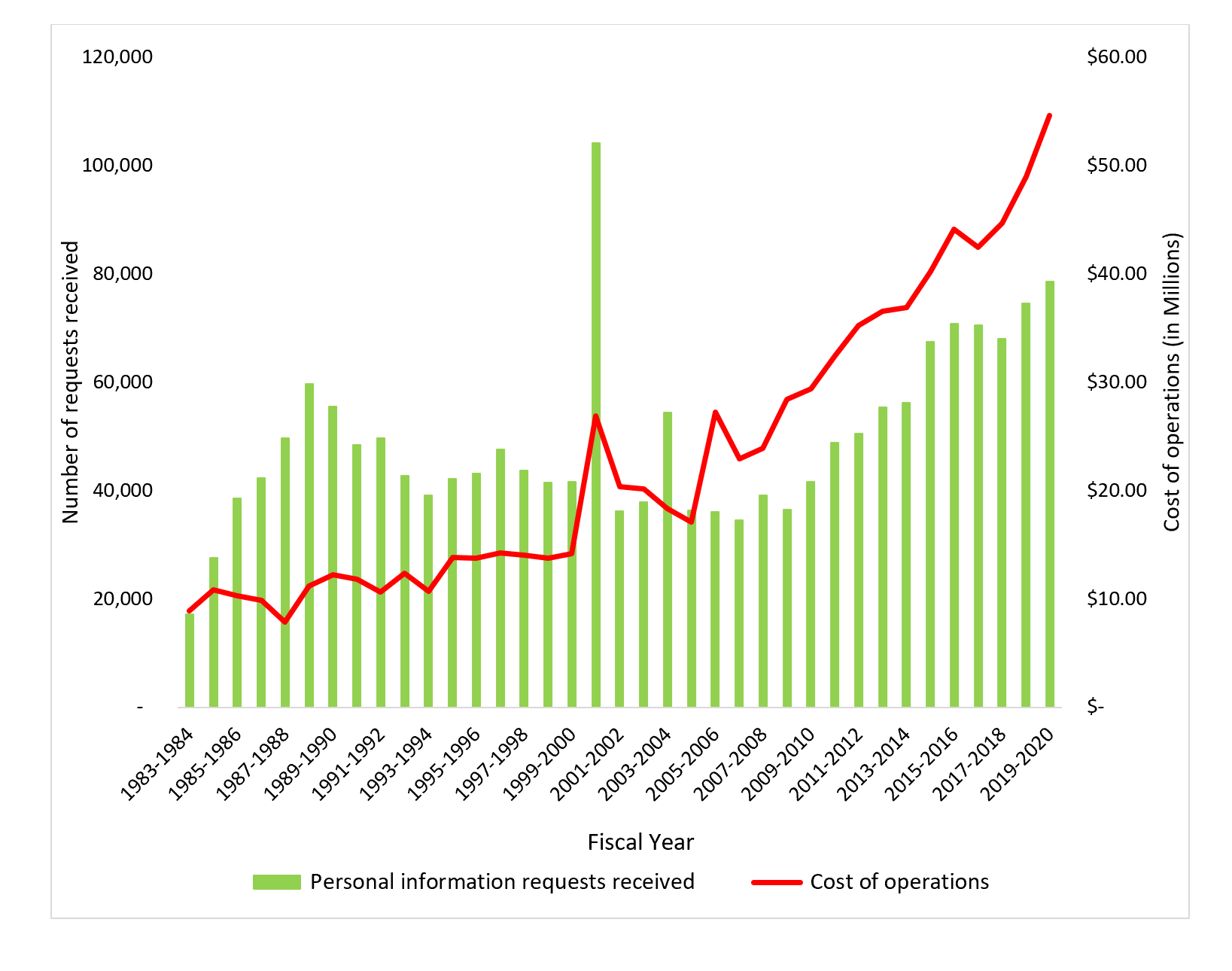
Figure 19 - Text version
| Year | Cost of operations (inflation adjusted)Figure 19 note * | Personal information requests received |
|---|---|---|
| 1983-1984 | $8.86 | 17,109 |
| 1984-1985 | $10.81 | 27,547 |
| 1985-1986 | $10.26 | 38,606 |
| 1986-1987 | $9.84 | 42,292 |
| 1987-1988 | $7.87 | 49,626 |
| 1988-1989 | $11.17 | 59,631 |
| 1989-1990 | $12.23 | 55,505 |
| 1990-1991 | $11.83 | 48,430 |
| 1991-1992 | $10.66 | 49,732 |
| 1992-1993 | $12.40 | 42,713 |
| 1993-1994 | $10.73 | 39,060 |
| 1994-1995 | $13.85 | 42,147 |
| 1995-1996 | $13.77 | 43,137 |
| 1996-1997 | $14.28 | 47,532 |
| 1997-1998 | $14.01 | 43,648 |
| 1998-1999 | $13.77 | 41,498 |
| 1999-2000 | $14.20 | 41,585 |
| 2000-2001 | $26.92 | 104,133 |
| 2001-2002 | $20.38 | 36,137 |
| 2002-2003 | $20.14 | 37,863 |
| 2003-2004 | $18.37 | 54,377 |
| 2004-2005 | $17.11 | 36,316 |
| 2005-2006 | $27.21 | 36,090 |
| 2006-2007 | $22.89 | 34,559 |
| 2007-2008 | $23.93 | 39,134 |
| 2008-2009 | $28.41 | 36,454 |
| 2009-2010 | $29.42 | 41,621 |
| 2010-2011 | $32.43 | 48,775 |
| 2011-2012 | $35.21 | 50,524 |
| 2012-2013 | $36.55 | 55,355 |
| 2013-2014 | $36.91 | 56,263 |
| 2014-2015 | $40.19 | 67,399 |
| 2015-2016 | $44.12 | 70,833 |
| 2016-2017 | $42.48 | 70,490 |
| 2017-2018 | $44.70 | 67,967 |
| 2018‑2019 | $49.00 | 74,566 |
| 2019‑2020 | $54.61 | 78,541 |
Figure 19 Note
|
||
Annex: detailed analysis
Requests under the Access to Information Act
Of the 156,222 requests that were received in the 2019 to 2020 fiscal year, 134,658 requests were received by five institutions, and 21,564 requests were received by the remaining government institutions. The five institutions receiving the highest volume of requests are Immigration, Refugees and Citizenship Canada (IRCC), the Canada Border Services Agency (CBSA), the Royal Canadian Mounted Police (RCMP), the Canada Revenue Agency (CRA) and Library and Archives of Canada (LAC). To provide a more detailed understanding of the access to information program, this Annex provides data for these five institutions.
| Requests under the Access to Information Act | Number of requests | ||||||
|---|---|---|---|---|---|---|---|
| IRCC | CBSA | RCMP | CRA | LAC | Other institutions |
Total | |
| Outstanding from 2018 to 2019 reporting period | 10,998 | 1,362 | 3,688 | 1,187 | 509 | 8,172 | 25,916 |
| Received during 2019 to 2020 reporting period | 116,928 | 8,223 | 4,512 | 2,864 | 2,131 | 21,564 | 156,222 |
| Total | 127,926 | 9,585 | 8,200 | 4,051 | 2,640 | 29,736 | 182,138 |
| Closed during 2019 to 2020 reporting period | 111,593 | 7,953 | 4,987 | 2,731 | 1,487 | 20,819 | 149,570 |
| Carried over to 2020 to 2021 reporting period | 16,333 | 1,632 | 3,213 | 1,320 | 1,153 | 8,917 | 32,568 |
The number of requests received by these five institutions increased by 36.3 percent since the last fiscal year, from 98,811 in the 2018 to 2019 fiscal year to 134,658 in the 2019 to 2020 fiscal year.
The number of requests received by all other institutions decreased by 12.4 percent since the last fiscal year, from 24,610 in the 2018 to 2019 fiscal year to 21,564 in the 2019 to 2020 fiscal year.
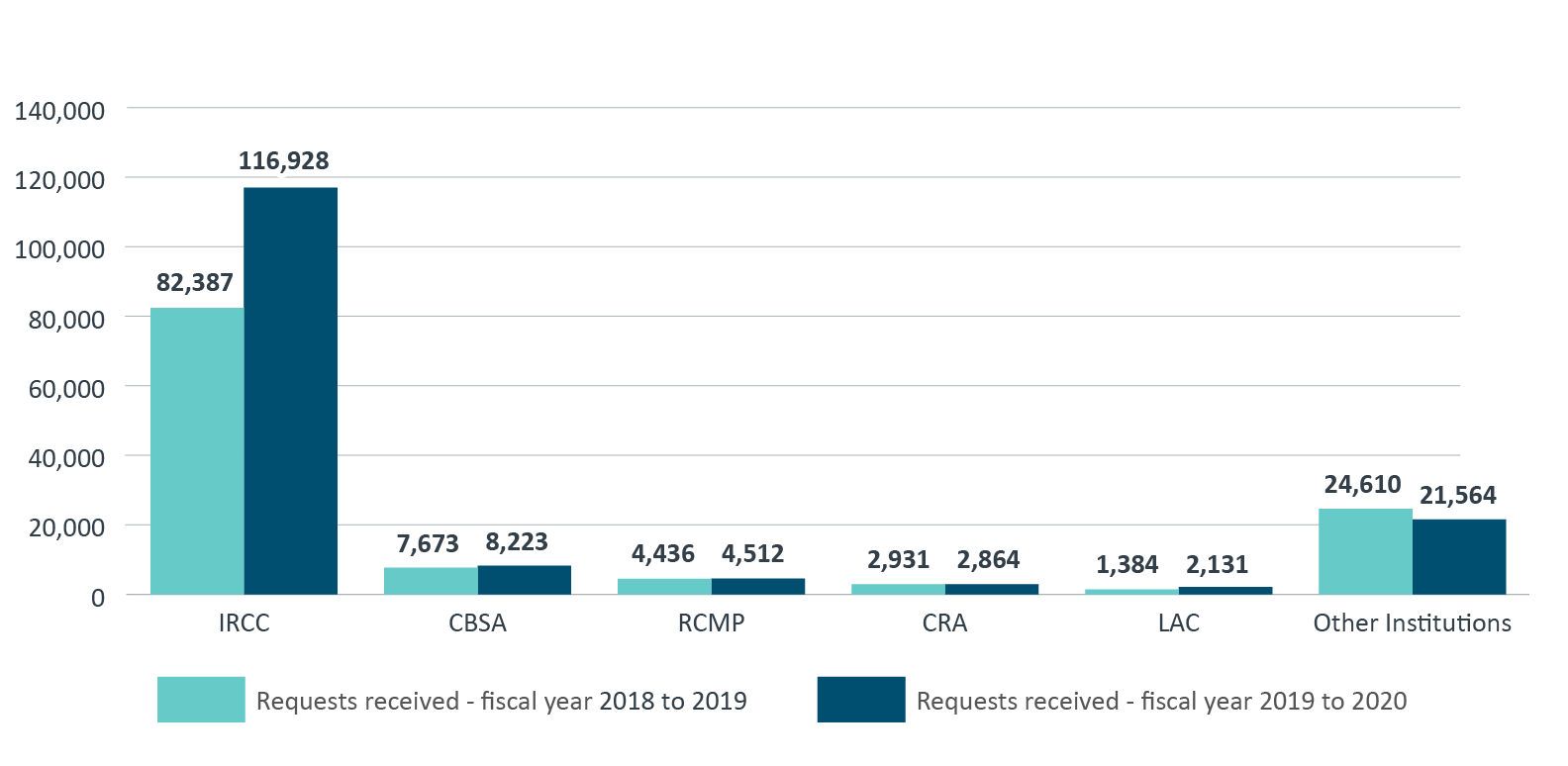
Figure 20 - Text version
| IRCC | CBSA | RCMP | CRA | LAC | Other Institutions |
|
|---|---|---|---|---|---|---|
| Requests received - fiscal year 2018 to 2019 | 82,387 | 7,673 | 4,436 | 2,931 | 1,384 | 24,610 |
| Requests received - fiscal year 2019 to 2020 | 116,928 | 8,223 | 4,512 | 2,864 | 2,131 | 21,564 |
The number of requests closed by these five institutions increased by 28.5 percent since the last fiscal year, from 100,231 in the 2018 to 2019 fiscal year to 128,751 in the 2019 to 2020 fiscal year.
The number of requests closed by all other institutions decreased by 16.2 percent since the last fiscal year, from 24,829 in the 2018 to 2019 fiscal year to 20,819 in the 2019 to 2020 fiscal year.
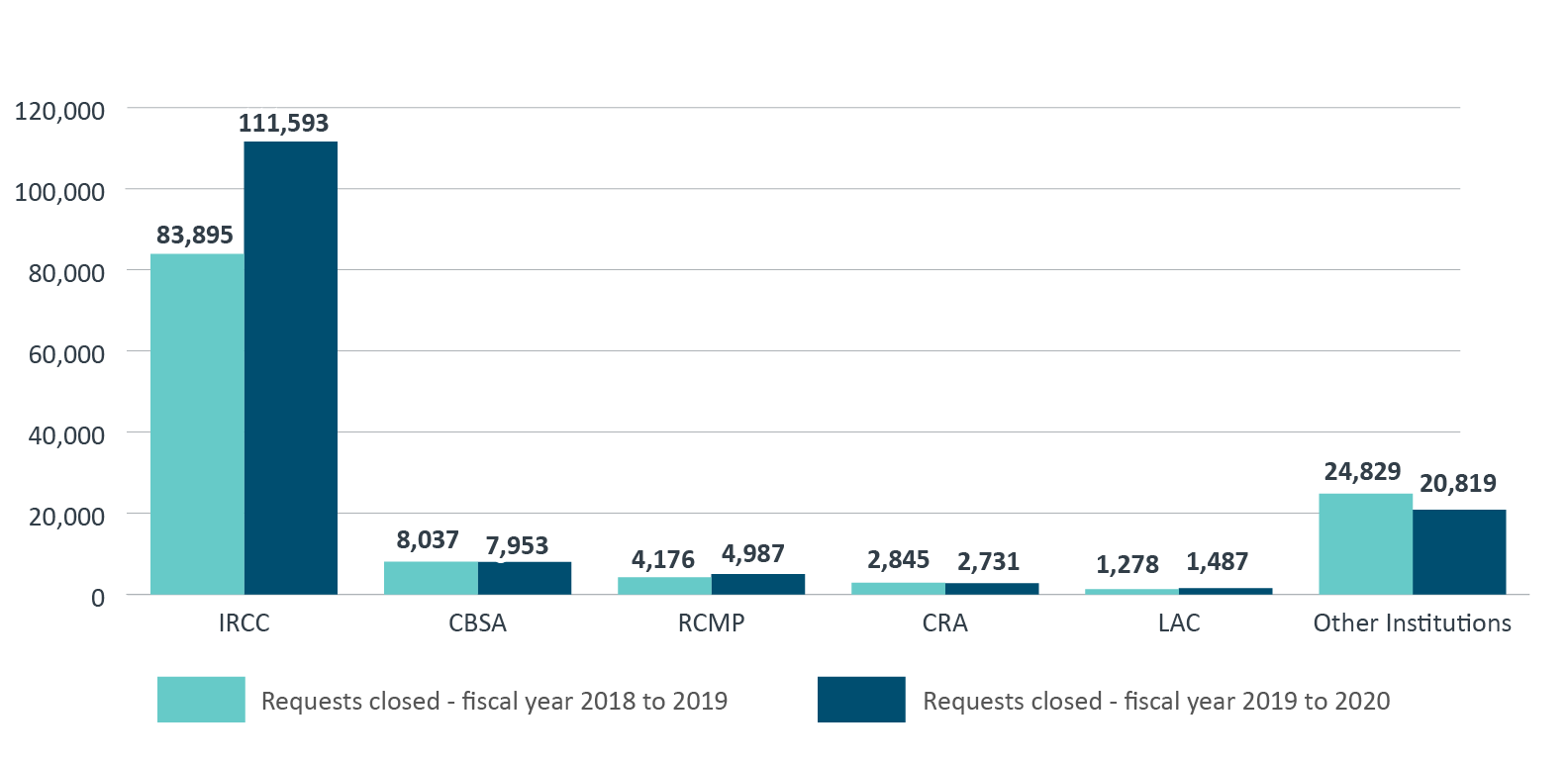
Figure 21 - Text version
| IRCC | CBSA | RCMP | CRA | LAC | Other Institutions |
|
|---|---|---|---|---|---|---|
| Requests closed - fiscal year 2018 to 2019 | 83,895 | 8,037 | 4,176 | 2,845 | 1,278 | 24,829 |
| Requests closed - fiscal year 2019 to 2020 | 111,593 | 7,953 | 4,987 | 2,731 | 1,487 | 20,819 |
Timeliness
Of the 128,751 requests closed by these five institutions in the 2019 to 2020 fiscal year, 65.4 percent were closed within legislated timelines, including extensions. This is a decrease of 5.9 percent from the 2018 to 2019 fiscal year.
For all other institutions, of the 20,819 requests closed in the 2019 to 2020 fiscal year, 80.1 percent were closed within legislated timelines, including extensions. This is a decrease of 0.4 percent from the 2018 to 2019 fiscal year.
| Status of closed requests | Number of requests | ||||||
|---|---|---|---|---|---|---|---|
| IRCC | CBSA | RCMP | CRA | LAC | Other Institutions |
All | |
| Closed within legislated timeline, including extensions | 59,146 (70.5%) |
7,577 (94.3%) |
1,197 (28.7%) |
2,308 (81.1%) |
1,182 (92.5%) |
19,992 (80.5%) |
91,402 (73.1%) |
| Closed beyond legislated timeline, including extensions | 24,749 (29.5%) |
460 (5.7%) |
2,979 (71.3%) |
537 (18.9%) |
96 (7.5%) |
4,837 (19.5%) |
33,658 (26.9%) |
| Total | 83,895 | 8,037 | 4,176 | 2,845 | 1,278 | 24,829 | 125,060 |
| Status of closed requests | Number of requests | ||||||
|---|---|---|---|---|---|---|---|
| IRCC | CBSA | RCMP | CRA | LAC | Other Institutions |
All | |
| Closed within legislated timeline, including extensions | 71,856 (64.4%) |
7,564 (95.1%) |
1,243 (24.9%) |
2,060 (75.4%) |
1,426 (95.9%) |
16,678 (80.1%) |
100,827 (67.4%) |
| Closed beyond legislated timeline, including extensions | 39,737 (35.6%) |
389 (4.9%) |
3,744 (75.1%) |
671 (24.6%) |
61 (4.1%) |
4,141 (19.9%) |
48,743 (32.6%) |
| Total | 111,593 | 7,953 | 4,987 | 2,731 | 1,487 | 20,819 | 149,570 |
Requests under the Privacy Act
Of the 78,541 requests that were received in the 2019 to 2020 fiscal year, 59,008 requests were received by five institutions, and 19,533 requests were received by all other institutions. The five institutions that received the highest volume of personal information requests are IRCC, Employment and Social Development Canada (ESDC), CBSA, Correctional Service Canada (CSC) and the Department of National Defence (DND). To provide a more detailed understanding of the privacy program, this Annex provides data for these five institutions.
| Requests under the Privacy Act | Number of requests | ||||||
|---|---|---|---|---|---|---|---|
| IRCC | ESDC | CBSA | CSC | DND | Other institutions |
Total | |
| Outstanding from 2018 to 2019 reporting period | 2,217 | 826 | 1,129 | 16,008 | 1,814 | 5,352 | 27,346 |
| Received during 2019 to 2020 reporting period | 15,963 | 15,405 | 14,102 | 7,063 | 6,475 | 19,533 | 78,541 |
| Total | 18,180 | 16,231 | 15,231 | 23,071 | 8,289 | 24,885 | 105,887 |
| Closed during 2019 to 2020 reporting period | 15,349 | 15,004 | 13,866 | 3,128 | 7,436 | 19,447 | 74,230 |
| Carried over to 2020 to 2021 reporting period | 2,831 | 1,227 | 1,365 | 19,943 | 853 | 5,438 | 31,657 |
The number of requests received by these five institutions increased by 8.2 percent since the last fiscal year, from 54,551 in the 2018 to 2019 fiscal year to 59,008 in the 2019 to 2020 fiscal year.
The number of requests received by all other institutions decreased by 2.4 percent since the last fiscal year, from 20,015 in the 2018 to 2019 fiscal year to 19,533 in the 2019 to 2020 fiscal year.
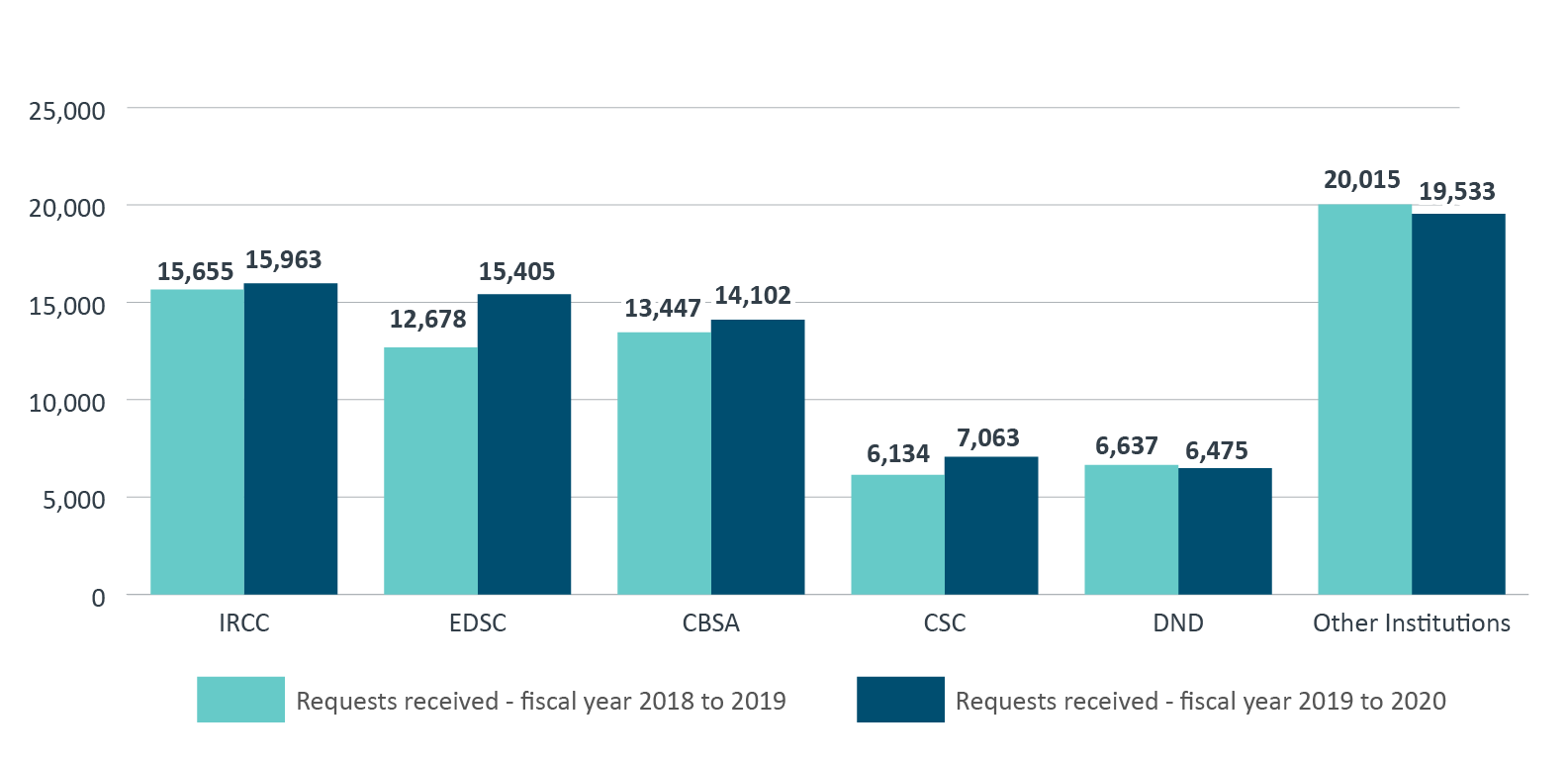
Figure 22 - Text version
| IRCC | ESDC | CBSA | CSC | DND | Other Institutions |
|
|---|---|---|---|---|---|---|
| Requests received - fiscal year 2018 to 2019 | 15,655 | 12,678 | 13,447 | 6,134 | 6,637 | 20,015 |
| Requests received - fiscal year 2019 to 2020 | 15,963 | 15,405 | 14,102 | 7,063 | 6,475 | 19,533 |
The number of requests closed by these five institutions decreased by 0.2 percent since the last fiscal year, from 54,880 in the 2018 to 2019 fiscal year to 54,783 in the 2019 to 2020 fiscal year.
The number of requests closed by all other institutions decreased by 2.7 percent since the last fiscal year, from 19,994 in the 2018 to 2019 fiscal year to 19,447 in the 2019 to 2020 fiscal year.
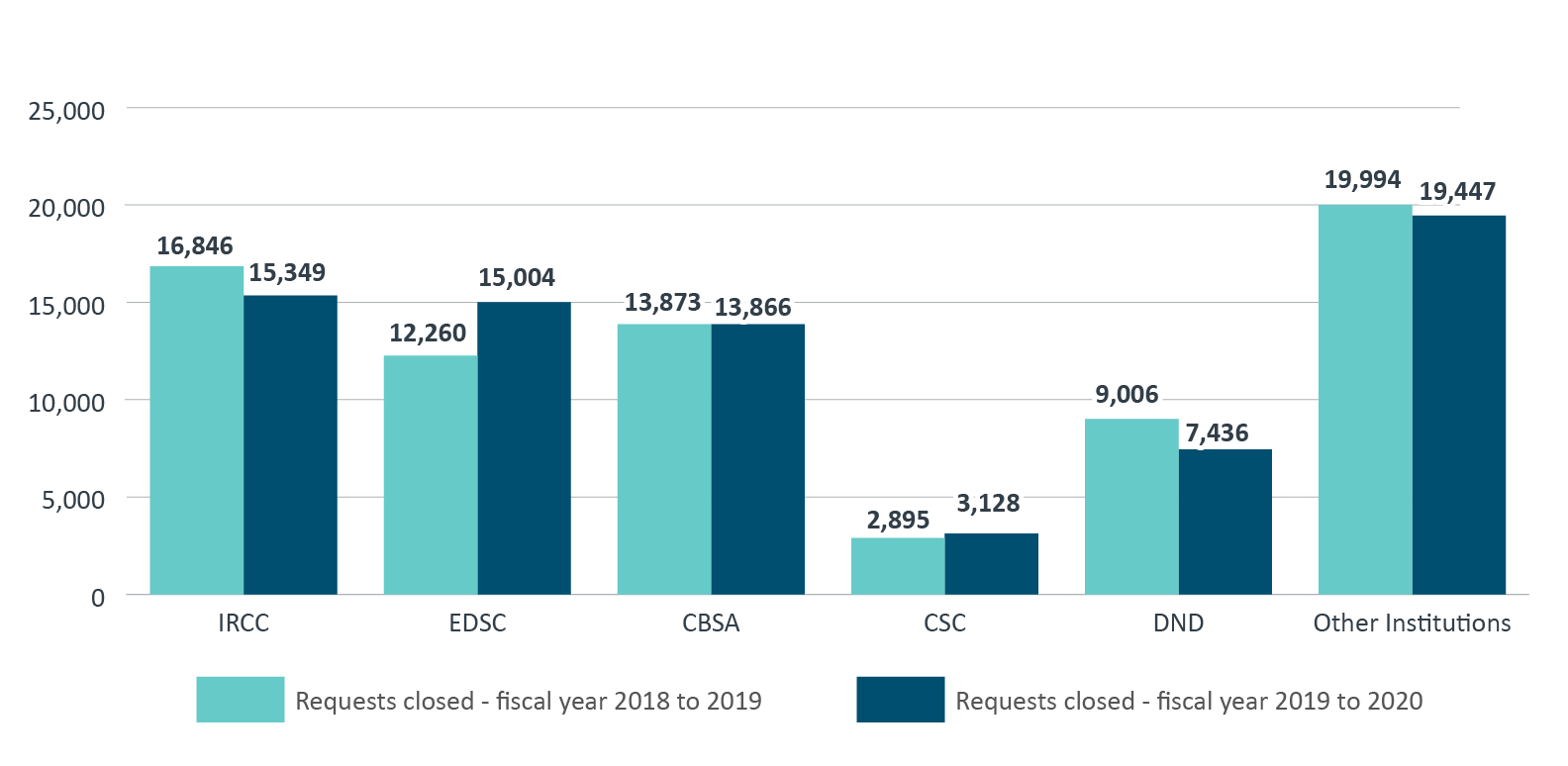
Figure 23 - Text version
| IRCC | ESDC | CBSA | CSC | DND | Other Institutions |
|
|---|---|---|---|---|---|---|
| Requests closed - fiscal year 2018 to 2019 | 16,846 | 12,260 | 13,873 | 2,895 | 9,006 | 19,994 |
| Requests closed - fiscal year 2019 to 2020 | 15,349 | 15,004 | 13,866 | 3,128 | 7,436 | 19,447 |
Timeliness
Of the 54,783 requests closed by these five institutions in the 2019 to 2020 fiscal year, 78.6 percent were closed within legislated timelines, including extensions. This is an increase of 3.8 percent from the 2018 to 2019 fiscal year.
For all other institutions, of the 19,447 requests closed in the 2019 to 2020 fiscal year, 79.9 percent were closed within legislated timelines, including extensions. This is a decrease of 1.6 percent from the 2018 to 2019 fiscal year.
| Status of closed requests | Number of requests | ||||||
|---|---|---|---|---|---|---|---|
| IRCC | ESDC | CBSA | CSC | DND | Other Institutions |
All | |
| Closed within legislated timeline, including extensions | 10,526 (62.5%) |
12,137 (99.0%) |
13,577 (97.9%) |
343 (11.8%) |
4,439 (49.3%) |
16,312 (81.6%) |
57,334 (76.6%) |
| Closed beyond legislated timeline, including extensions | 6,320 (37.5%) |
123 (1.0%) |
296 (2.1%) |
2,552 (88.2%) |
4,567 (50.7%) |
3,682 (18.4%) |
17,540 (23.4%) |
| Total | 16,846 | 12,260 | 13,873 | 2,895 | 9,006 | 19,994 | 74,874 |
| Status of closed requests | Number of requests | ||||||
|---|---|---|---|---|---|---|---|
| IRCC | ESDC | CBSA | CSC | DND | Other Institutions |
All | |
| Closed within legislated timeline, including extensions | 8,410 (54.8%) |
14,949 (99.6%) |
13,663 (98.5%) |
488 (15.6%) |
5,542 (74.5%) |
15,547 (79.9%) |
58,599 (78.9%) |
| Closed beyond legislated timeline, including extensions | 6,939 (45.2%) |
55 (0.4%) |
203 (1.5%) |
2,640 (84.4%) |
1,894 (25.5%) |
3,900 (20.1%) |
15,631 (21.1%) |
| Total | 15,349 | 15,004 | 13,866 | 3,128 | 7,436 | 19,447 | 74,230 |